One thing that I remember dearly from my childhood is eating milk buns with a small chocolate bar. It was something so simple that brought so much happiness into my days. Those milk buns were very soft and fluffy and had the perfect structure so you could buy the ones filled with whipped cream and they wouldn’t be soggy. I think the simplicity of these milk buns is what makes them so special, they’re such a delicious treat!

What are milk buns?
When you talk about milk buns these days, people usually think about a pull-apart style of buns. But today I bring a Spanish version of milk buns (Or at least the milk buns from my childhood). They have a slightly thicker (not crunchy) crust with a very spongy and slightly moist crumb. They’re usually shaped into an oblong shape and they don’t touch each other while they bake. Many times you could find milk buns filled with whipped cream or custard, those were some chubby buns!
About this milk buns recipe
Before we start, I want to emphasize how important gluten development is in this recipe. These milk buns should stay soft and fresh for several days, and proper gluten formation is crucial. I’ve tested this recipe many times and the yudane (I’ll talk about it later) definitely helps, but good ole’ elbow grease is what’s going to help you take these buns from good to amazing!
Activate the yeast in milk
I find that scalding the milk always helps when making bread. What I like to do is boil part of the milk (exact measurements in the recipe card), and let it cool down as I prepare the rest of the ingredients. Once the milk is warm and nice to the touch I add the yeast and let it rest a few minutes to activate.
Try acid whey for extra milkiness
I’ve been making my own yogurt for a few months and I found a perfect way to use the leftover acid whey: Bread making! Check this sandwich loaf recipe. I also found that whey gives the bread a more intense aroma than milk, so if you like your bread extra milky, and you have leftover whey, you can also use it for this recipe.
How to make the buns super soft
The key to ultra-soft milk buns is gluten development. By gluten development, I don’t mean *just* gluten formation. But developing a gluten network that is reinforced by fats and starch. Those are the key components to any soft bread. Different recipes will have a slightly different gluten network organization, but the idea is to have these three ingredients create a sturdy network (a good foundation starts with gluten) that is elastic and malleable (fats, they act as a lubricant among the gluten chains), and that makes a bread that is very spongy and fluffy (starch helps with setting the crumb and creating a more cohesive and less crumbly texture).
What is the yudane method?
One of the things that happen in breadmaking is the gelatinization of starch. The liquids in the recipe hydrate the starch in the flour. The hydrated starch granules swell and burst open when the temperature increases while the bread is baking. This is called gelatinization. The yudane method is based on the incorporation of pre-gelatinized starch into the bread recipe. Adding pre-gelatinized starch means two things: 1) more gelatinized starch will increase the fluffiness of the bread, and 2) pre-gelatinized starch will avoid “stealing” part of the moisture of the recipe for starch swelling, rather than gluten building. So we end up with a bread that is fluffier and has a stronger gluten network.
How does yudane look like
It is basically a 100% hydration dough. It looks sticky! Don’t worry, the main purpose of yudane is to gelatinize as much starch as possible. At this point, we don’t care about kneading the dough perfectly.
Later, when you put all the ingredients together, the yudane will incorporate into the dough and you wouldn’t tell it’s there
How to make the yudane
In order to keep the flavor of the milk buns, I like to prepare my yudane with milk. For these buns, I boiled the other part of the milk (careful with spills!) and prepare the yudane with it. You can do this the day before, but I prefer to use my yudane fresh to make sure there is no starch retrogradation. You can learn more about it in this post
If you use a stand mixer, you can put the flour for yudane in the bowl beforehand. Once the milk starts boiling turn the stand mixer on, add the milk, and knead the dough using the paddle attachment. If you prefer to do it by hand use a heavy bottom bowl that can stand the heat and allows you to stir somehow vigorously. Add the flour and when the milk is boiling aff it to the bowl and start stirring until you form a dough. Knead until you can touch the dough and don’t get burnt.
When the yudane is done, wrap it with plastic wrap and let it cool down to room temperature. In the meanwhile prepare the rest of the ingredients.
Fermenting these milk buns
You have two options here, 1 bulk fermentation and 1 proof, or 2 bulk fermentations and 1 proof. What I like to do with these buns is to ferment the dough until it almost doubles in size, then knead it for a minute to deflate it and let it ferment again until it doubles in size. Only then do I deflate it for a second time and divide it to shape the buns.
I find 2 bulk fermentations help develop more flavor. This is a yeasted dough, so any extra aroma is always welcome! And if you’re wondering if longer fermentation will make this dough sour the answer is no! It’s not sourdough, so don’t worry about that. It’ll just have a more bready and less yeasty flavor.
However, if you prefer to do one single bulk fermentation, let the dough ferment until it doubles or almost triples. Then proceed with the shaping and proofing.
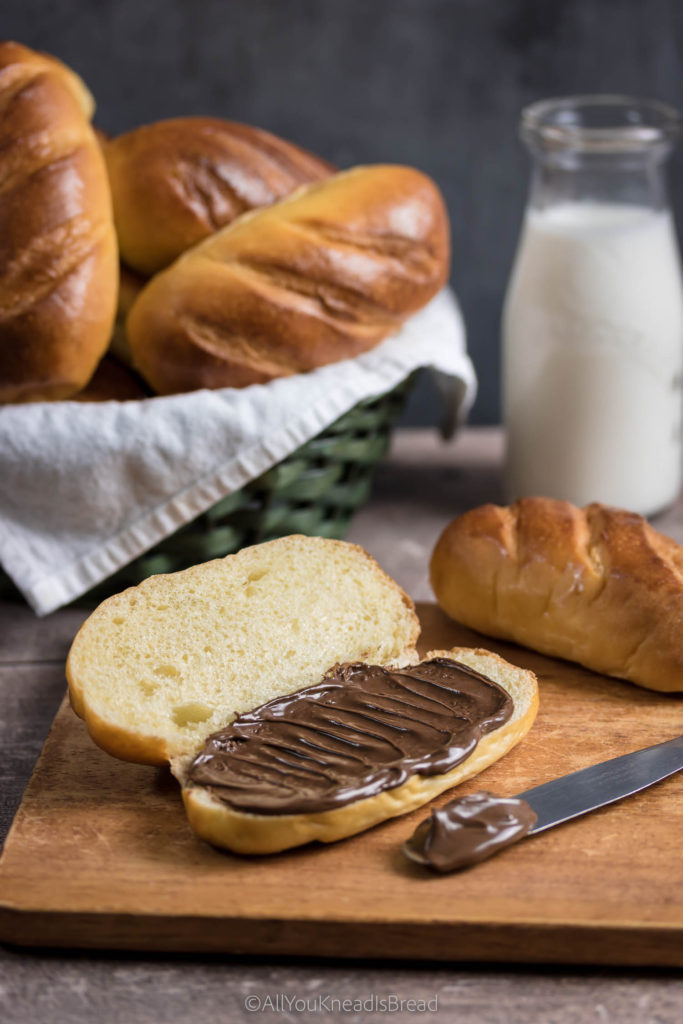
How to shape these milk buns
After the dough is ready and has fermented. Divide it into 20-25 pieces of similar weight, shape them into a ball, and let them rest for 10 or 15 minutes. I like smaller and chubbier buns, but you can make larger buns. In that case, divide the dough into 10 or 12 pieces.
Then, with your hands or a rolling pin, flatten the balls, one at a time, into an oval of 15-20 cm long and 15-10 cm wide. This depends on how you like your buns. (shorter and chubbier, or thinner and longer. I like the chubbier version better!)
Then starting from the narrow side roll the dough into a little log, seal the edges and place it on the baking tray you will use. Leave enough separation amount the buns so they don’t touch each other while fermenting or baking.
If you’re making small buns you will need 2 or 3 trays to proof them or they might be too close to each other and will end up touching each other in the oven.
Score the buns!
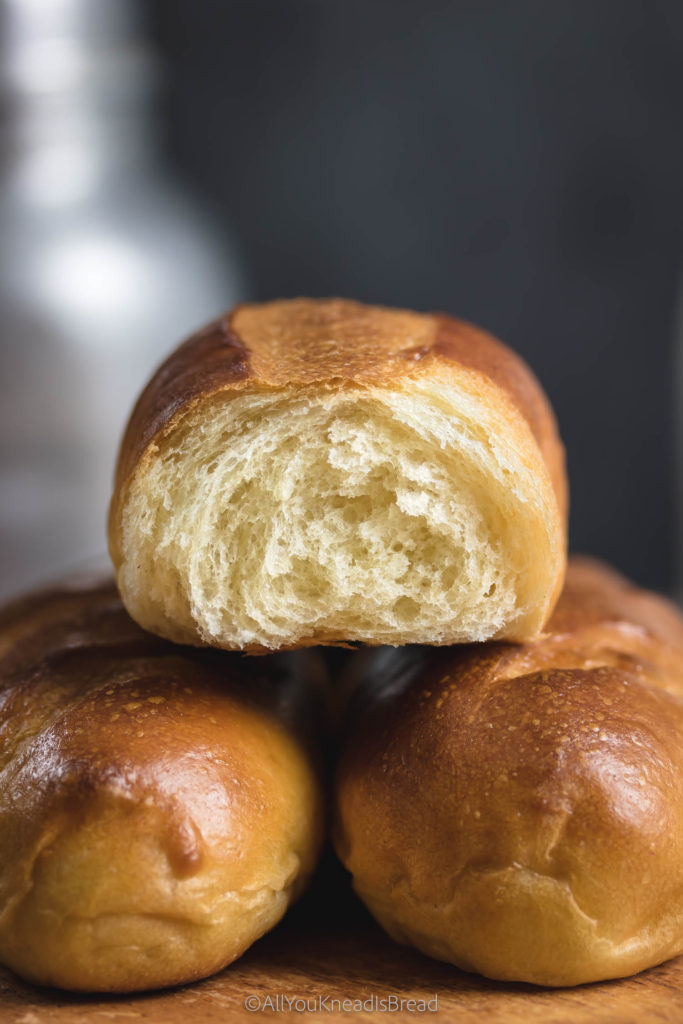
One of the times I was testing this recipe I asked my Instagram community which scoring pattern they liked better, and the majority responded that they liked better 3 cuts across the buns. I had tried no cuts and also one cut lengthwise. I like 3 cuts better, as well. But, of course, you can choose whatever pattern.
How to bake the milk buns
If you choose to make small buns, be careful because they will be done fast and they can go from almost brown to dark brown in a matter of minutes. I don’t use steam while I bake these milk buns but that’s also an option to consider if you have an oven with a fan. The fan always dries out the crust much faster.
If you decide to make larger buns, then adding some steam can be a good idea, to allow the buns to rise a bit more in the oven.
The power of a good egg wash
Egg wash is not only the last touch for some shiny buns, it also develops a crust that seals part of the moisture inside to the buns can last fresh for a bit longer.
Questions you might have
How long do milk buns last?
I made 25 small buns and, at room temperature, they lasted fluffy and nice for 3-4 days. On days 5 and 6 the buns were a bit dryer but still edible. Nothing some butter or mayo couldn’t fix!
Can you freeze milk buns?
Yes! I reserved some of the buns for freezing. The best way for me was a ziplock bag, but you could wrap them in plastic wrap individually as well. Then I cut them lengthwise before freezing and when I wanted to eat one I just popped it in the toaster. You could also let them thaw at room temperature or steam them. Although this last technique can be tricky if there’s water condensing and dripping on top of the buns.
How do you eat milk buns?
As mentioned before, these milk buns are probably a bit different than other styles of buns. They are perfect for sliders, hotdogs… whatever savory filling you prefer. But my favorite is with a chocolate bar. This combination just takes me back to my childhood and I see myself in that small pastry shop, unwrapping the chocolate bar and putting it inside the bun. As an adult, I found that Nutella can also be an amazing filling!
Are milk buns sweet?
Yes! These buns are sweet, not crazy sweet but you can taste the sweetness. That, along with the milky flavor, is what makes these buns so versatile! They go well with sweet or savory fillings. And if you’re like me and dunk everything in your morning coffee… you can do that too!
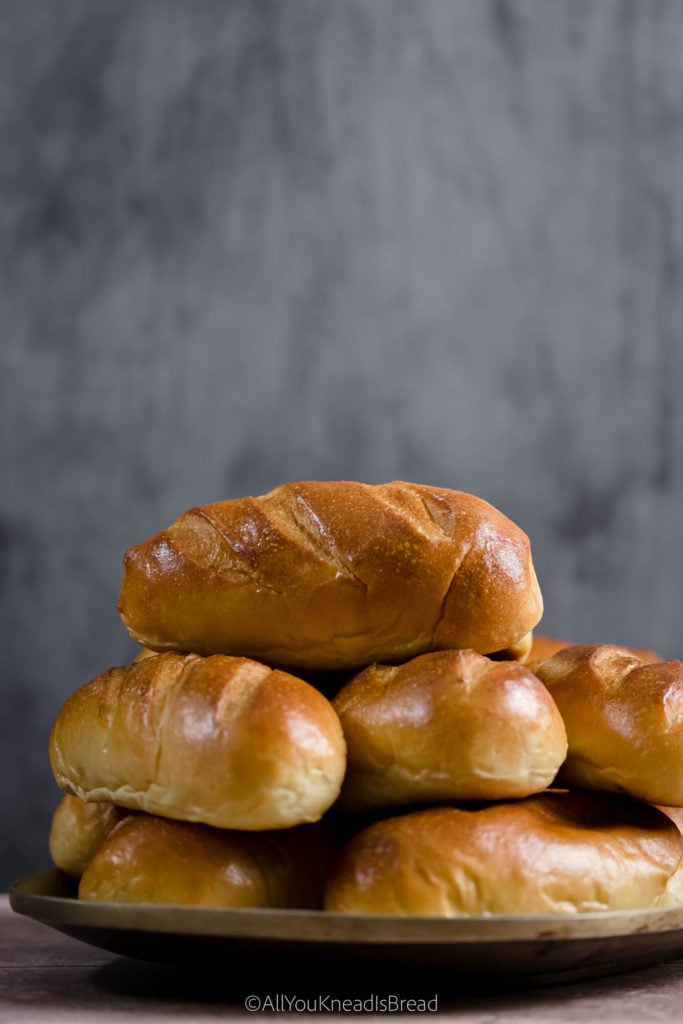
Are these milk buns the same as brioche?
Not quite! While brioche is mostly eggs and butter, these buns have more milk, not as much butter, and not that much egg. They are also sweeter than brioche.
Other uses for this milk dough
This dough is amazing to work with! Unless I don’t have a lot of time I like to knead it by hand because it’s truly nice to work with! And it’s also very versatile. If you don’t want long buns you can you can make buns for burgers, or cinnamon rolls, or a babka… You can also shape it into thinner and longer buns for hot dogs. You can even use it to make a tin loaf. This recipe is a keeper!
If you liked this recipe you might also like these
Super fluffy nuts and cardamom babka
Orange and cinnamon sourdough rolls
Sourdough donuts with rose cream
If you make any of my recipes let me know what you think! As always you can find me on Instagram, Pinterest, and Facebook. And I also have a few videos up on my Youtube channel (which I hope I can resume soon!)
Starting on breadmaking but don’t know where to start? Check my amazon store to see my favorite and affordable utensils you will need. You can make the best bread with simple and affordable tools! (This is an affiliate link if you purchase something from this link I will make a small commission that helps me run this blog, but you will not be charged any extra money 😉 )

Super soft milk buns
Ingredients
Yudane
- 150 g bread flour
- 150 g boiling milk
Main dough
- 300 g yudane
- 600 g bread flour 12.7% protein
- 300-335 g Whole milk (scalded, lukewarm) (start with the lesser amount and add more if your flour requires it)
- 75 g heavy whipping cream
- 3 egg yolks
- 7 g active dry yeast
- 90 g sugar
- 12 g salt
- 75 g softened butter
Instructions
Yudane
-
Add 150g of bread flour to your bowl.
-
Heat a bit over 150g of whole milk and when it comes to a boil weigh 150g and quickly add it to the flour.
-
With a wooden spoon or with a stand mixer mix the flour and milk until it forms a sticky dough. Wrap it in plastic and keep it at room temperature until you're ready to start the dough.
Main dough
-
Mix the lukewarm milk, the whipping cream, the yeast, and the egg yolks, and let the mixture sit for 10 minutes.
-
Add the sugar to the egg mixture and give it a whisk.
-
In the bowl where you have your yudane add the egg mixture and break up the yudane a little bit.
-
Add flour and salt to the bowl where you have the yudane and pour the wet ingredients. Mix everything until you don't have dry flour particles. Cover and let it sit for 20 minutes.
-
After 20 minutes start kneading, if the dough feels too stiff and you didn't add all the milk, add a bit more. Once the dough starts coming together add the softened butter and continue kneading to incorporate it.
-
Knead until the dough becomes smooth and elastic. It shouldn't stick to your fingers and it should feel nice to the touch.
-
Place the dough in a lightly oiled container, cover it and let it ferment at room temperature for 2h or until it almost doubles in size
-
Deflate de dough gently and let it ferment again for 1 hour or until it almost doubles the size
-
After 1h or when the dough is ready deflate it gently and let it rest, covered, for 10 minutes.
-
Divide the dough into as many buns as you'd like, shape the pieces into small balls and let them rest covered for 10 minutes. This recipe can make 25 small buns, 12 medium buns, or 6 large buns.
-
Take one dough ball and flatten it with your hands or a rolling pin into an oval of half centimeter thick (1/4 in). For small-size buns, the oval will be 15x7cm. Starting from the short side roll the dough into a log and seal the edges.
-
Put the buns on baking trays separate enough they won't touch each other while they bake, cover them loosely with plastic wrap and let them ferment until they get puffy and have grown in size.
-
Before the buns finish proofing preheat your oven at 360F/180C (lower to 340F if you're making larger buns).
-
When the buns are ready, brush them with a mix of milk and the leftover egg white, make three cuts across the surface of each bun and bake them at 360F/180C for 25-35 minutes or until they have a nice golden brown color.
-
Let the buns cool down to room temperature. You can keep them in a seal-tight container or ziplock bag at room temperature. You can also freeze them and defrost them in the toaster.
The best Sourdough Fougasse With Pasta Madre discards
Lately, I’ve been focusing on my Pasta Madre a lot. While studying it and playing around with different flours I generated a considerable amount of pasta madre discards. Of course, I found a way to repurpose them instead of throwing them away. I made this fantastic sourdough fougasse with olives and thyme that is going to blow your taste buds! This is the most aromatic sourdough fougasse I’ve ever made! It’s definitely a delicious treat to share and a fantastic appetizer to keep your guests happy while dinner is finishing cooking!

What is fougasse bread?
In a world full of focaccias, baguettes, and sourdough loaves it’s easy for this incredibly delicious bread to go unnoticed. Let me tell you a bit about it!
Fougasse is a French bread typical from Provence although it has more variants in other regions of France. It’s somehow a flatbread and it’s shaped in an irregular shape with slits in the middle. In France is very common to add fillings such as olives, cheese, anchovies…
FUN FACT! this bread was originally used to test the temperature of the wood fire ovens they had back in the day. The bakers could estimate the temperature based on how long it took to bake a fougasse. So there you have it, delicious bread full of tradition!
What is pasta Madre?
In case you’re not familiar with it, let me make a quick summary of what pasta madre is: It’s a special stiff starter used in the making of Grandi Lievitati products, namely Panettone, Pandoro, Colomba… I said special because it’s not *just* a stiff stater. Pasta madre, (or lievito madre, or lievito naturale in some cases) is typically maintained under pretty specific conditions and methods. The method I use is the one where the starter is kept in water. The other method wraps the pasta madre and keeps it tied.
If you want to learn more about it you can check this post to learn how to create your own lievito madre, this post for information about the 3 preparatory refreshments before making panettone, and this post for a mini-guide to troubleshoot your pasta madre.
Stiff starter vs. Pasta Madre, two different things
Social media has done a very poor job of explaining what Pasta Madre is. And frequently people use starters at 60% hydration and call them Pasta Madre. But a real pasta madre s about 35-45% hydration (depends on the flour). And it has a very controlled maintenance process in order to keep a healthy ratio of bacteria and yeasts and promote specific types of LAB. The purpose of this special maintenance is to make a panettone (Grandi lievitati) that is very very very soft, packed with flavor, that can stay fresh for many days and that has not a single hint of acidy nor acidifies over time. Not just to leaven the dough.
Why do I generate so many pasta madre discards?
The thing is… because Pasta Madre is kept either in water or tied up, you can’t really use small amounts of flour because otherwise it’d disintegrate in the water very quickly or it’ll completely dry out in the cloth. My normal maintenance amounts are:150-200g of pasta madre, 150-200g of very strong flour, and 70-80g of water.
Basically, I generate about a pound of pasta madre discards every 24h. And that is a lot of perfectly fine and very strong pasta madre that could be used for other things. I usually keep it in the fridge and accumulate it over a few days and use it to make crackers. I also use it for sourdough loaves, or to make these delicious orange and cinnamon rolls.
And now we have another recipe! This sourdough fougasse is good! Trust me on this! And it uses about all the discard from one refreshment.
If you are using pasta madre discards, I recommend you start the fougasse dough right after the last maintenance refreshment. That is when the pasta madre is at its peak of activity.
Is this a sourdough discard recipe?
Yes, because pasta madre is still sourdough, and a very active one! It’s still a dough packed with wild yeasts and bacteria. And like sourdough discards, you can use it in pretty much anything! It’s also great for stiffer dough, you can use it to make bread like this sourdough challah, or my sourdough burger buns… The options are endless here!

What if I don’t have pasta madre?
Don’t worry! If you don’t have pasta madre you can either create a stiff starter and use it, or use your liquid sourdough starter (100% hydration), I got you!
How to create a stiff starter with your 100% hydration starter
I’m going to show you how to make a shortcut stiff starter at 55% hydration because if we lower the hydration too much, your bacteria will end up a bit stressed and there’s a chance it won’t be active enough to use. You can read all about adaptation periods and water content on this post. It’s about the science of your sourdough starter (without fancy words and easy to follow).
A 55% hydration starter would be very easy to make by mixing 100g of flour with 55g of water. But this will make a total of 155g of starter. We don’t need that much, so we need to scale it down to a total of 100g. So we need to scale down.
| Ingredients | For 155g of starter | For 120g of starter | For 100g of starter |
| Total Flour | 100g | 77.4g | 64.5g |
| Total Water | 55g | 42.6g | 35.5g |
Pay attention to the water
Now, water is our limiting factor here because we just need a little amount. Since we’re using our 100% hydration starter, that means that whatever weight of this starter is made of 50% flour and 50% water.
So, let’s say you want to make 120g of stiff starter (just to play safe). That starter will have 42.6g of water. This water comes ONLY through your liquid starter. Since water is only 50% of the liquid starter, we will need twice the amount. And then to make it stiffer we just add the flour difference. Let me show you!
Twice the amount of 42.6g (of water we need) is 85.2g. We need to take 85.2g of liquid starter (42.6g of water, and 42.6g of flour). And according to the table above, to make 120g of stiff starter we need a total of 77.4g of flour. From our liquid starter, we already have 42.6g of flour. The difference we need to add is: 77.4 – 42.6 = 34.8g
Let me do the math for you!
Too much math for a beautiful day such as this one? Then let me do the numbers and just pick on the table below the amount of starter you prefer to make:
| Ingredient | For a total of 120g of stiff starter | For a total of 100g of stiff starter |
| 100% hydration starter | 85.2g | 71g |
| Extra flour | 34.8g | 29g |
You can now pick how much stiff starter you want and mix the ingredients. Knead the dough by hand for a couple of minutes. You don’t need to develop the gluten perfectly but make sure there aren’t dry flour particles or dry chunks of dough. The idea is to have a dough that is stiff but workable and not sticky. Aim for a bagel dough kind of consistency.
Once mixed put it in a container with a loose lid and wait until at least doubles in size. It’d be helpful to have a narrow and taller container rather than a wider and shorter one. That way it’ll be easier to see how much it grows. Once you see it doubles wait for a while, if it stalls then it’s at the peak, if it continues growing then it’s not at the peak yet. Wait a bit longer and test again.
You also need an active starter to make sure the stiff starter can grow fast and you don’t need to refresh it again to make it stronger. Remember, the purpose of this recipe is to reduce waste 😉
If this is not a method you like, I got you! You can go ahead and use your liquid starter
How to make sourdough fougasse with liquid starter
If you just don’t really care about making a stiff starter or don’t have pasta madre, you can still make this delicious sourdough fougasse with your liquid starter. Just add 100g of the starter and then 21g LESS of water and 21g MORE of flour to the base recipe and you’re good to go! (This is to keep the total dough hydration the same regardless of the starter you’re using).
About this sourdough fougasse recipe
For this fougasse, I chose strong-flavored fillings because pasta madre doesn’t have the sour punch that liquid sourdough has. It’s a milder flavor that I wanted to balance with something savory. Olives and thyme are a combination that I love and along with olive oil and the bread (once is baked) is just perfect.
You can use other ingredients of your preference, although traditionally fougasse has more savory and umami fillings. This can also be an opportunity to let your creativity flow and experiment with how you cut the slits when you’re shaping your bread. Fougasse is truly a gorgeous bread that can just be the perfect centerpiece for a table.
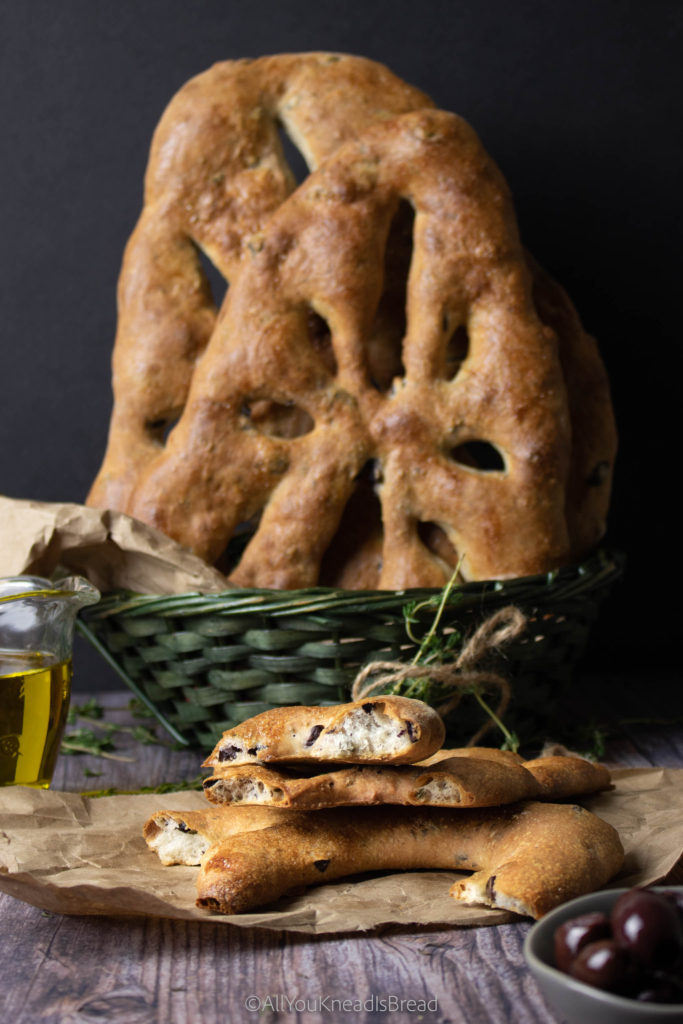
How to prepare this sourdough fougasse
As with any other sourdough bread, we need to start mixing the ingredients. If you know my baking style, you know that I add starter and salt all at the same time. And this case is no different. However, due to the nature of pasta madre, you probably can’t dissolve it in the water the same way you do with a liquid starter.
What I like to do is hold back about 20% of the water to start with a bit of stiffer dough, and then progressively add the rest of the water and finally the wet fillings. This is what works for me, but if you want to add all the water right away and just knead directly it’s fine too.
This is a lovely dough to work with, honestly. You can use your stand mixer but if you want to try doing it by hand, I think it’s a beautiful recipe to do so!
If you’re using a liquid starter just dissolve it in water and proceed with the rest of the ingredients. You don’t need to add water slowly.
When should I add the fillings?
I like to classify fillings into two groups: wet and dry. Wet fillings are those that carry a considerable amount of moisture with them and that could, potentially, alter the dough. These are things like olives, roasted peppers, capers… Dry are those that don’t carry with them much moisture like spices, herbs, cured cheese, dry things preserved in oil (sundried tomatoes, caramelized onion…).
Why this classification? When we need the dough we usually apply pressure to the ingredients that are in the dough. Wet ingredients will release that moisture if we “squeeze” them as we knead the dough. And our somehow stiff dough can become sticky in no time!
What I like to do is add the dry ingredients mixed with the flour and wait until the dough is developed to add the wet, then I just have to knead enough to incorporate the fillings, and not for incorporating them filings and developing the gluten at the same time.
For this sourdough fougasse, I used black olives and thyme. Thyme is not a problem, it’s a “dry” ingredient (even though I used fresh herbs, but you get the idea), you can add it at the beginning with the flour and the other ingredients. Olives, on the other hand, are preserved in brine, they carry quite an amount of moisture. So I added them at the very end. Once the dough was ready and the gluten was where I wanted it to be, I added the olives and kneaded just enough to incorporate them.
Don’t worry if by doing this you still have a couple of olives that aren’t incorporated, just put them on top of the dough, after they bake they’ll give your fougasse a rustic look!
How to ferment this sourdough fougasse
Since fougasse is a flatbread of sorts, it’s okay if the dough is not super strong. In other words, it’s okay if we over ferment it a little if that’s going to fit our schedule better. Here you have a couple of options:
Same day fougasse
Start the dough early in the morning, knead it well, add all the fillings, and let it ferment (bulk ferment) until it doubles in size and gets a bit puffy. Depending on your temperature, this might be anywhere between 3-5h. If you’re using a clear bowl you should see some fermentation bubbles in the bottom but nothing too crazy. Try not to over ferment it or when you want to shape it and cut the slits it’ll be tricky.
Then proceed to divide the dough into as many fougasses as you wish to make, shape them, and let them proof. We’re not looking for super chubby fougasses here. So when you start seeing them rising a bit turn the oven on and continue proofing while the oven preheats.
If you’re an early bird you might have them ready by lunchtime, if you’re a sleepyhead like me, maybe aim for dinner to be safe 🙂 *giggles as she writes this sentence*
Overnight fougasse
This method is based on cutting the bulk and keeping the dough in the fridge until you’re ready to continue. So, let’s say you refresh your pasta madre in the early evening or your stiff starter is not ready until later in the day. Maybe you don’t have time to bake your fougasse the same day. In this case, what you can do is prepare the dough and start the bulk fermentation. Then 1 and a half or two hours later put the bowl in the fridge and keep it there overnight. Then the next morning take the dough out of the fridge and divide it into the number of pieces you want. This way the dough will come to room temperature a bit faster
How to shape your sourdough fougasse
Either if you are following the same-day method or the overnight method. After dividing the pieces shape them into a ball, cover them with a cloth or plastic wrap, and let them rest for 20 minutes or so.
After the rest period is over… Unleash your inner creativity! The basics of shaping a fougasse are:
Flatten the piece of dough into an oval-ish/triangular-ish/leafy-ish shape, then cut slits with a bench scraper or a pizza cutter (bench scraper works better for me), loosen up the slits, and done!
Don’t try to make them perfect, the beauty of a good fougasse is in that rustic touch! I personally like a triangular/leafy kind of shape. I think they look really nice and if you have a bread basket they will look very cute in it. Also, feel free to use plenty of flour to avoid the dough from sticking to the counter. Cutting the slits can be tricky.
Baking your sourdough fougasse
Once you’re done shaping the fougasses, cover them and let them proof at room temperature until they start getting puffy, but didn’t necessarily grow much. At that moment turn your oven on at 425F/220C. The proofing stage will continue as the oven preheats. If you have an old metallic tray, put it in the bottom part oven, you will use it to create steam.
When the oven is ready put your fougasses in the middle part of the oven and throw a cup of boiling water into the bottom tray. This will create a nice touch of steam for the first few minutes.
After 10 minutes or so, you can retrieve the bottom tray and continue baking until your fougasses have a nice golden brown color. Let them cool down on a rack until you can hold them with your hands without burning yourself and enjoy!
A few tips about this sourdough fougasse recipe
For a shiny touch, I like to brush my fougasses with egg wash. This also allows the crust from drying out too quickly. This bread is pretty thin, so a bit of extra moisture is always helpful.
If you don’t want to brush your fougasses with egg wash, you can spray some water before putting them in the oven. This, along with the steam we create with the boiling water, it’ll be enough.
Fougasse is best consumed right away. When it’s crispy outside and soft inside. It’s even better when it’s still warm. This bread is thin, most of the moisture scapes as it bakes, so it goes stale faster than other types of sourdough bread.
Can I use other fillings?
Absolutely! You can use other flavor combinations that you like. I love fresh herbs combined with something extra savory or umami (like olives, blue cheese…). But I also love caramelized onions and nuts together. The sky is the limit here!
Do I really need steam to bake it?
You don’t need it, but I think it’ll be a good idea. I always get better results when I add steam during the first 10 minutes of baking. Since these are pretty thin, the crust will dry out quickly. A bit of steam will help to create a fluffy interior and crispy crust! But if you can’t create steam don’t worry, your fougasse will still turn out delicious!
How big should my fougasse be?
With this recipe, you can make one mega-fougasse, 2 large fougasses, 3 medium fougasses, 4 small ones, or 5 tiny ones. Just be careful when you bake them because the small ones will bake faster.
That is all for today! If you liked this recipe, you might also like these other ones, give them a try and let me know what you think!
Brie and olive sourdough rolls
Tomato and rosemary sourdough bread
Gorgonzola and apple sourdough bread
If you make any of my recipes let me know what you think! As always you can find me on Instagram, Pinterest, and Facebook. And I also have a few videos up on my Youtube channel (which I hope I can resume soon!)
Starting on breadmaking but don’t know where to start? Check my amazon store to see my favorite and affordable utensils you will need. No need to buy a $200+ baking pot. You can make the best bread with simple and affordable tools! (This is an affiliate link if you purchase something from this link I will make a small commission that helps me run this blog, but you will not be charged any extra money 😉 )
Happy Baking!
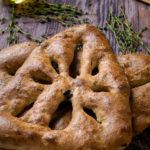
Sourdough Fougasse with pasta madre discards
Make this incredibly aromatic bread typical from the Provence using your pasta madre discards!
Ingredients
- 500 g bread flour
- 100-120 g pasta madre discards see notes
- 300-350 g water see notes
- 50 g extra virgin olive oil
- 8-10 g salt see notes
- 135 g sliced black olives drained and patted dry
- 10 g fresh thyme leaves chopped
- 1 egg for brushing optional
Instructions
-
Mix salt, chopped thyme, and flour in a bowl and set aside
-
Cut the pasta madre into smaller pieces and add them into the bowl that has the flour mix
-
Add about 80% of the water, the olive oil, and start kneading until you feel the pasta madre is incorporating well into the dough. Then add the rest of the water
-
Knead the dough until the gluten is almost developed and add the drained olives
-
Do a set of stretches & folds to help incorporate the olives. If the dough feels tight and you can't incorporate them, let the dough rest for 20 minutes to relax the gluten. Then proceed again to finish incorporating the olives
-
Once ready lightly oil your bowl and put the dough inside, let it proof at room temperature until it doubles or almost doubles and you see some fermentation bubbles at the bottom (Refer to the post to see how you can do a cold retard of this dough)
-
When the bulk fermentation is over, lightly flour your counter and divide the dough in as many fougasses as you want (3-4 pieces will have a nice medium-small size). Shape the pieces into dough balls, cover them and let them rest 10 minutes
-
Take one dough ball and flatten it with your fingers giving it an oval or semi triangular shape. With your fingertips stretch the dough into a larger piece of about 1cm/0.5in thickness. Use as much flour as needed to avoid the dough from sticking
-
Once you have shaped all pieces cover them and let them rest for 10 minutes
-
Place the pieces on the trays you will use to bake them and with the narrow side of a bench scraper cut slits into the fougasse pieces and stretch them a little so the cuts don't close while the dough proofs and bakes
-
Cover the fougasses and let them proof until you see them getting puffy, then turn on the oven at 425F/220C and finish proofing while the oven preheats. If you want to create some steam place an old metallic tray in the bottom part of the oven
-
When the oven is ready brush the pieces with egg wash for a shinier touch (optional) or just spray some water. Bake them for about 30 minutes or until they get a nice golden brown color. If you are creating steam in the oven you can add a cup of boiling water into the tray that has been preheating in the bottom of the oven.
Recipe Notes
*If you are adding wet fillings (like olives) start with the lesser amount of water, if the fillings are dry (like herbs or cheese), add the greater amount of water
*Use just 8g of salt if you’re using very salty/umami fillings like olives, anchovies… otherwise use 10g
Gorgonzola and apple sourdough bread – Video

Hello friends!
I’ve decided that it was about time for me to post some sourdough bread recipe and spread the sourdough fever!
Before I start I’d like to make something clear:
There isn’t just one single method to make sourdough. Any bread, really. But especially sourdough. My method works for me because I’ve adapted it to my kitchen conditions, my flour, and our taste buds.
If you’re new to sourdough baking take this recipe as a guide and experiment with what you like
Since sourdough is the result of wild yeasts and bacteria fermentation, it’s unique for each person. Each starter is different because the flours used are different, the water quality is different, the temperature in each person’s kitchen is different…
Sourdough for beginners: what I wished someone told me when I first started
My very first sourdough bread was… pretty messy! I was intimidated and I thought that not following the recipe by the minute was going to turn my bread into something awful “OMG! It has fermented 5h and 1 minute!” So here are some of the things that I learned along the way:
1. Don’t worry! You can adapt the fermentation time to your own schedule. Sometimes deciding what you’re going to do with the bread is more difficult than actually making the bread. The more you bake, the more you learn.
2. Experiment, try different things. Shorter bulk fermentation, longer cold-proof… whatever works for you!
3. Flour flour flour! Flour your banneton, flour your dough and flour everything so the dough doesn’t stick to the banneton or the cloth. Too much flour ain’t never enough flour! After all the work you don’t want the dough to stick to the banneton or the cloth right before baking. Some people like to use rice flour or starch because they absorb more water and the dough never sticks. I found that all-purpose flour works great, as long as you use enough.
4. If anything, it’s better to under-ferment than over-ferment. Why? Scientifically speaking, the gluten network of over fermented dough loses strength and it’ll be difficult to shape, it won’t hold the shape during baking, and it’ll have a terrible oven spring because the lack of strength means less ability to hold gas inside (it’s the same concept as to over-knead the dough). Also, and this is my opinion, some people might disagree, but it’s been helpful for me: slightly under fermented dough has more chances to turn into a great bread than over fermented dough. The crumb might not have super large holes, or maybe you don’t have that tart taste you’re looking for, but the dough will hold the shape better, the oven spring will be better, and overall the bread will be better than an over-proofed one.
5. Make sure the gluten is developed. Either if you knead the dough by hand, on a stand mixer or if you do a “no-knead” bread. The dough has to be elastic and smooth, it shouldn’t be sticking everywhere. If you are kneading, there shouldn’t be dough on the walls of the stand mixer bowl, or on the counter. The dough has to be strong enough to be able to pull itself together without breaking. If you’re making “no-knead” bread, you should be able to stretch the dough without it tearing apart.
6. Shape the loaf well, don’t be afraid. During shaping, you’re going to use that strong gluten network that you’ve built to be able to create surface tension. That means that you’re going to stretch the outer layer of gluten in a way that will help keep the shape tight and in place, but if you push too much, the layer will eventually tear apart, and the bread won’t hold the shape. I like to think about it as covering a bowl with plastic wrap, you need the wrap tight in order to be in place, but if you pull too much, you will tear it.
7. Don’t get overwhelmed by information. The Internet is packed with sourdough recipes, methods, how to build a starter… My advice? Pick one method to build your starter and stick to it until you’re comfortable enough. Each method will be different and will be adapted to each baker. That’s why they’re all so different and why I don’t want to add more information about it, there’s just too much out there. If you really want to know how I built my starter, how I care for it etc. feel free to contact me and I’ll be more than happy to help!
8. BE PATIENT. Bread making is all about patience. If your first bread doesn’t turn out great, don’t worry! Keep trying. Write down what works, and what doesn’t. And if you want to experiment, change only 1 or 2 things at a time so it’ll be easier for you to narrow down what went wrong, what worked, what’s creating problems…
Let’s get to the recipe!
Gorgonzola cheese has a very intense flavor, it should be consumed in small amounts, so your palate is not overwhelmed and you get to enjoy all the aromas and flavors.
Apple is a sweet fruit but not too sweet that would take over the cheese taste. Actually, it helps your taste buds to balance everything every flavor.
And the bread, of course… the sourdough taste, the airy crumb, the slightly crunchy crust…

Are you drooling yet? I thought so 😊
I used 100g of gorgonzola (half packet) and 1 medium-large fuji apple. You can go for a tarter apple or a sweeter one.
I’ve tried this recipe with different water contents and the bread has always turned out very similar. The cheese fat and the water in the apple are essential to get the super soft bread. And because of those, the crust is crunchy but thin, so it’s not hard at all.
You’ll see how light and springy this bread is!

This bread is just amazing! I never recommend to eat the bread warm, but for this one? I can’t tell you to wait until it’s cooled down. Just give it 30 mins to set the crumb and go ahead! And since it has both savory and sweet, you can combine it with anything you want!
If you make this bread make sure you tag me on Instagram! I’d love to see what you made!
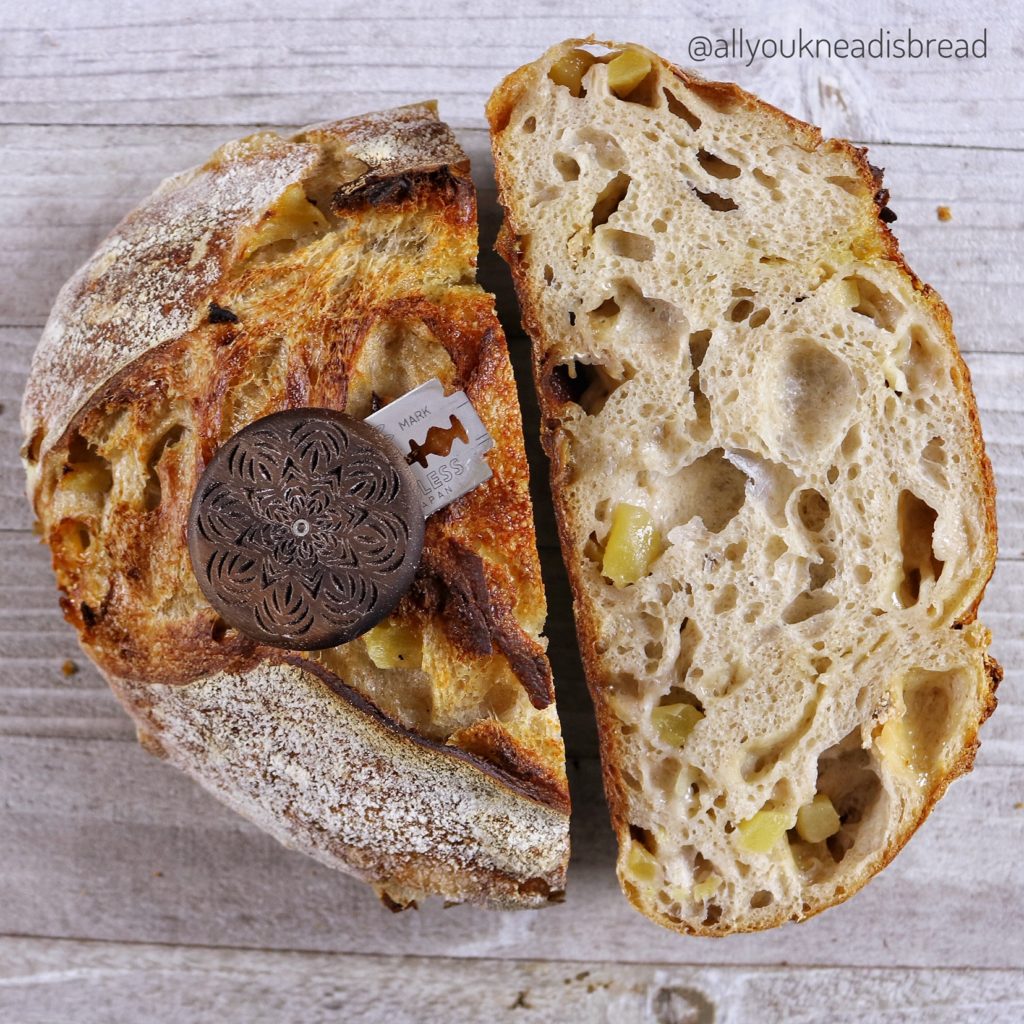
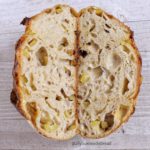
Gorgonzola & apple sourdough bread
This bread is very soft with incredibly balanced aromas
Ingredients
- 320 g bread flour
- 80 g whole wheat flour
- 320 g room temperature water
- 80 g 100% hydration starter
- 1 medium fuji apple
- 120 g gorgonzola cheese
- 7 g salt
Instructions
-
Mix flours and water (you can add less water if an 80% hydration is too much for you). Let the dough rest for up to 3h (autolysis)
-
Add the salt and mix the dough until you don’t feel salt particles. Wait 30 minutes
-
Add the starter, incorporate it very well and let the dough rest for 30-45 minutes
-
Peel and chop the apple and cut the cheese into small cubes
-
Laminate the dough: use your fingers and stretch the dough from the center towards the outside, don’t worry about the shape. Add the apple and the cheese and distribute them well. Fold the dough and shape it into a ball and place it back in the bowl. Wait for 45 mins
-
Do three sets of coil folds or stretch and folds every 45 mins (time can vary between 30-60mins). After the last set of fold, let the dough ferment until it doubles in size, the time depends on the temperature of the dough and the temperature of your kitchen (it can be anywhere from 3-8h)
-
Flour the counter well, let the dough fall from the bowl onto the counter by itself and shape it into a batard or a boule
-
Line a banneton with a clean cotton cloth and flour it generously. Place the dough into the banneton with the seam up and stitch the seam. Cover the dough with the cloth and put it in the fridge for 8-24h (If you don't have a banneton you can use a bowl).
-
Preheat your oven at 450F with a dutch oven inside (or a pizza stone or a baking tray) for at least 30-40 minutes
-
Take the dough out of the fridge and place it on a piece of parchment paper. Score the dough with a sharp knife or blade. Put it in the dutch oven and reduce the oven temperature to 425F . **See notes
-
Bake 20 mins with the lid on and another 15-25 mins without the lid or until it has browned nicely (depending on your oven the bread might be done earlier or later)
-
Cool on a cooling rack for 30 mins to let the crumb set and enjoy!
Recipe Notes
** If you don’t have a dutch oven, place another baking tray in the bottom rack while the oven it’s preheating. Add a cup of boiling water to that baking tray right after you put the bread inside and close the oven door fast. After 20 minutes remove that tray and bake the bread for another 20-25 minutes. If you use a pizza stone, be careful to not add the boiling water on it or it’ll, most likely, break.
Best (and vegan!) pumpkin bread – Video
Hello friends!
Are you ready for some pumpkinlicious bread? Yeah, I just made a word up. But only because I couldn’t find one that fits this bread!

These days Instagram is packed with pictures of pumpkin bread and pumpkin buns and pumpkins in general and I couldn’t let it go, I had to post my recipe.
I’ve made different types of pumpkin bread before, but my favorite is the recipe I’m posting today.
Why, you may ask?
Because it’s full of flavor, it’s soft, it’s sweet and has a lovely shape!
And it’s accidentally vegan!
I say accidentally because I wasn’t really planning on making this bread vegan, it just happened! Lately, I’ve been using the Country Crock line of plant-based butter. I’ve tried them all and I love the result in bread! (This is not an ad, I’m just letting you know the dairy-free butter that I use)
This recipe yields 2 medium pumpkin-shape loaves. You can divide it into more loaves, or you can make one larger loaf. Just keep in mind that you’ll have to adjust your oven temperature.
I personally prefer medium to large loaves using this recipe. Since the bread doesn’t have eggs, smaller shapes will dry out quicker.
This bread is very soft, you don’t even need a knife to cut through it, the shape makes it easier to pull a piece :o) It’s also sweet enough to enjoy with both savory and sweet food. Did I mention is super soft?
How come it is so soft… if it doesn’t have eggs?
Miracle pumpkin puree! The carbohydrates (fiber included!) of this orange vegetable play a significant role in keeping the moisture in the bread. Pumpkin has starch, and when you boil it, some of that starch is gelatinized and able to keep the moisture in. Also, the pumpkin particles are not too hard, and they do not disrupt the gluten network like cereal bran could do, allowing the dough to develop properly and become very elastic.
Oh, and pumpkin is PACKED with antioxidants, carotenes to be exact. It’s all goodies in here!
So, without further ado… Let’s carve this pumpkin!
You can watch the video for more details on how to make this bread.
The first thing you need to do is dissolve the yeast into 3 Tbsp of the total amount of water.
While you let the yeast activate mix the pumpkin puree and the sugar in a different bowl. When the yeast is ready, add it to the pumpkin mixture and combine everything well. Let it rest while you prepare the other ingredients
Mix the flour, the salt and the pumpkin spice powder in a larger bowl.
Grate the butter and mix it with the flour. If you don’t have a grater you can use a pastry blender or cut it in smaller pieces and use a fork. The idea is to have small pieces of butter mixed in with the flour.
This dough is not too hydrated so adding the butter later would be a bit difficult. I found that grating the butter makes the process easier while still having great results. The butter will be absorbed in the dough as you knead it.
Add the wet ingredients to the flour/butter mixture and combine everything. Start adding the leftover water 1 oz at a time. Depending on your flour you might not need all of it. I use King Arthur bread flour and I used all 115 ml of water.
NOTE: If you add too much water, the dough will be too hydrated and the pumpkin won’t hold the shape in the last proofing.
The dough should feel soft, slightly sticky but it should hold the shape for several minutes.
Alrighty! Once the dough comes together, let it rest for a few minutes and start kneading!
Knead until it’s soft and shiny and it doesn’t stick to your fingers or your working surface.
If you feel the dough is not coming together let it rest for a few minutes and continue kneading.
Shape the dough into a ball and place it in a lightly oiled bowl. Let it rise until it doubles in size. It should feel puffy and soft and smell yeasty.
Deflate the dough well, the crumb of this bread doesn’t have large alveoli so try to get rid of large air pockets.
Divide the dough into 2 pieces of similar weight and pre-shape them into a ball. Don’t worry if one is slightly larger than the other one. They don’t have to be perfect.
Cover them and let them rest for a few minutes.
In the meanwhile, prepare the thread.
Cut 8 pieces of 45 cm (18 in)
In a small bowl add 2 tbsp of vegetable oil and soak the threads well. This will avoid leaving thread debris on your loaves and it’ll make easier to take them off after baking.
Place 4 pieces of thread on the table, crossing each other by the middle part and making sure that there are 8 spaces of similar size, watch the video for better understanding.
Take one of the dough balls and shape it into a ball. Try to create some tension so it’ll hold the shape better, and place it on top of the threads.
Tight the threads, not too tight, not too loose, just enough. As the dough ferments, it’ll puff up and the pumpkin shape will become more obvious.
Do the same with the other piece of dough
Cover the pumpkins with plastic wrap and let them ferment until you see the pumpkin shape. Don’t worry if it is a bit asymmetric.

About 20 mins before the proofing ends, turn your oven on at 375 F.
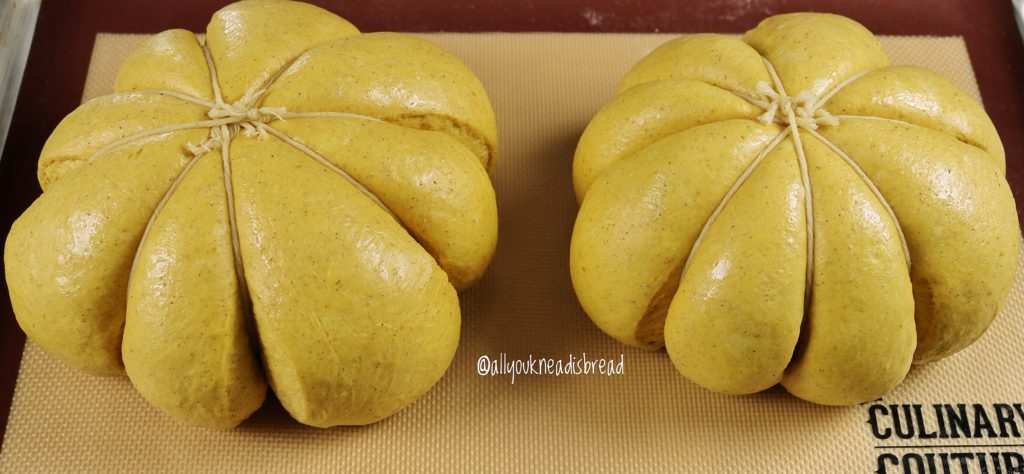
If you want, you can brush the pumpkins with vegetable milk (or regular milk if you don’t mind about dairy). I used soy milk on mine.
Put the pumpkins in the oven, lower the temperature to 350 F and bake the bread for 35-45mins (time depends on your oven), or until they’re golden brown.
If the loaves are getting too dark but they’re not done yet, lower the temperature to 330F or cover the pumpkins with aluminum foil.
After they’re baked, let the pumpkins cool down in a cooling rack for 30 minutes to an hour before you take the threads off.
This is important, you have to let the crumb set before you take the threads out. If they get stuck in the crumb, carefully pull them, one at a time, and they will slip out of the bread.
OPTIONAL: When the bread has cool down completely, take 2 cinnamon sticks and insert them on the top of the bread, this way your pumpkins will look really cute and can decorate your table while your guests arrive! Or just look incredibly beautiful for your next Instagram post.
And now it’s the best part… It’s time to enjoy your pumpkin bread!
See you next bake!

Best Pumpkin Bread
Bun-like pumpkin bread with incredible aroma and delicate crumb
Ingredients
- 500 g bread flour
- 300 g pumpkin puree (canned or homemade)
- 80 g vegetable butter
- 4 g active dry yeast
- 120 g water
- 6 g salt
- 40 g sugar
- 3 tsp pumpkin spice (add as much/little as you want)
- 2 tbsp vegetable oil (to soak the threads)
- 8 pieces food grade thread (45 cm / 18 in)
- vegetable milk for brushing
- 2 sticks cinnamon for decoration
Instructions
-
Dissolve the yeast in 3 tbsp of the total amount of water and let it rest a few minutes
-
In a small bowl mix the pumpkin puree, the sugar, and the yeast solution
-
In a bigger bowl, add the flour, the salt, the pumpkin spice, and mix well
-
Grate the vegetable butter and add it to the flour. Using your hands, mix the flour and butter
-
Add the pumpkin mixture to the flour and combine
-
Add the leftover water and incorporate all the ingredients well until you don't see dry flour particles. Let it rest for 20-30 min (autolysis)
-
Knead the dough until it's soft and shiny. You can do it by hand or with a stand mixer
-
Lightly oil a bowl and place the dough inside. Cover it and let it rise until it doubles in size
-
Deflate the dough gently and let it rest a few minutes.
-
Divide the dough into 2 similar pieces, pre-shape them into balls, and let them rest 5-10 mins
-
In the meanwhile prepare the threads. Cut 8 threads (food grade) of 45 cm (18in) long and soak them into 2tbsp of vegetable oil
-
Put 2 threads making a cross on the table, and 2 more making an X (Try to put them as center as possible)
-
Take one piece of dough, shape it into a tight ball and place it on top of the threads
-
Tie the thread tight enough so they won't fall apart but loose enough you don't push the dough. Do the same with the other piece of dough.
-
Preheat your oven at 350F
-
Cover the pumpkins and let them rise until you see the pumpkin shape
-
When ready, brush them with vegetable milk and bake them for 35-45 minutes (depends on your oven)
-
Let the loaves cool for 30 mins before you take the threads out. And let them cool completely before cutting through them
-
OPTIONAL: Insert a cinnamon stick on top of the loaves for decoration
Recipe Notes
If your loaves are browning too quickly, lower the oven temperature to 330 F and put foil on top if necessary.
Delicious Nuts & Cardamom Babka – Video
It’s that time of the year again!
Fall is here and with it, all holidays and family & friends gatherings. Although, to be honest, sometimes I feel like I’m running out of ideas of what to bring to a party. Luckily for us all, I came up with a wonderful one!
Jump to Recipe
Babka!
You might think it’s not very original but this babka is different! I’ve developed a dough that keeps soft and fresh for many days, and a filling that’s unique and delicious! Oh, and also VERY customizable to fit everyone’s needs and preferences!
Nuts & cardamom babka!
In my opinion, babka is the perfect bread to play around with flavors and fillings. Firstly, because the dough it’s not too sweet and goes great with everything. Secondly, because it’s a beautiful bread!
Babka bread is a Polish Jewish bread (The non-Jewish babka is a cake rather than bread). The word “babka” comes from the Slavic word “babcia” which means “grandmother”.
Apparently, grandmas are worldwide known for making the yummiest food!
Babkas gained popularity after Polish people brought the recipe to New York City, and today is a very well known and loved sweet bread.
Although the original recipe called for a cinnamon filling, babka nowadays is made with plenty of other fillings, both sweet and savory.
On this recipe, I used pecans, hazelnuts, and almonds for the filling. I added cardamom powder and orange blossom water to make a paste with the ground nuts. And O EM GEE!
Note: You can find orange blossom water in Asian or Arabic stores. If you don’t live close to any, you can also find it on Amazon.
Okay, let’s talk nerdy for a minute!
One of the problems of bread (any bread) is shelf life. It dries out rather quickly (aka bread staling). However, when fats and sugar are added to the dough, the bread tends to last a bit longer because of how the fats and the gluten proteins attach to each other, and how the starch granules help give the gluten network elasticity and keep the moisture in the crumb. Okay, so what happens when we add nuts to the equation, especially when they are ground?
I’ve been thinking a lot about this, and although the dough ingredients and procedure definitely help, based on my reading and nerdy research, the oils in the nuts are released while cooking the paste, and during the baking process. The way babkas are shaped, they have several layers of filling. So, the layers of nut paste might stop the crumb moisture from leaving the bread so fast. Therefore, if it takes longer for the moisture to leave the bread, the bread will stay soft for longer time. Although I highly doubt this babka will last long!
There’s always a but…
But… adding nuts cannot make up for insufficient kneading. You still have to knead your dough well. The dough of this recipe is pretty sticky, but it does come together at the end. Check my brioche recipe to get directions on how to knead enriched dough.
You have to do it in batches. Knead a few minutes, let the dough rest a few minutes. You will see how after stopping for 5-10 minutes the dough is much more elastic and comes together much better. Don’t freak out if you spend a whole hour (with rests included) kneading. There’s nothing wrong with the dough. Eventually, it’ll become soft and elastic and shiny and it’ll have little blisters on the surface, and it won’t be sticky!
Never get intimidated by the time you spend kneading, it’s easier to not knead enough than to over work the dough.
Let’s start with this yummy recipe!
You can make this recipe with regular milk and butter, but I also tested a non-dairy version using soy milk and almond oil butter (it’s the one on the video) and it worked perfectly! If you use milk, just make sure you boil it first. Boiling the milk breaks down some enzymes that affect the development of the dough.
As always, activate the yeast first, then add the sugar and eggs and combine well.
Add the salt to the flour and mix the wet ingredients with the dry ingredients.
When you don’t see dry flour particles, cover the dough and let it rest a few minutes.
Start kneading and when you feel the dough is starting to get elastic add the butter or dairy-free spread.
I used Country Crock plant butter, the one with almond oil, and the dough turned out great! (Not an ad, I’m just letting you know what worked for my dairy free version ;] )
Incorporate the butter well and keep kneading. Let the dough rest as many times as you need, if you feel the dough is not coming together, stop, cover it, let it rest 5-10 mins and start again.

Avoid using too much flour while you knead, it will break the balance of the ingredients and your babka will end up drier. Trust in the power of gluten!
When the dough is elastic, it passes the windowpane test, it’s shiny and has blisters covering the surface it’s ready! You can stop kneading, shape it into a ball, and place it in a lightly oiled container.
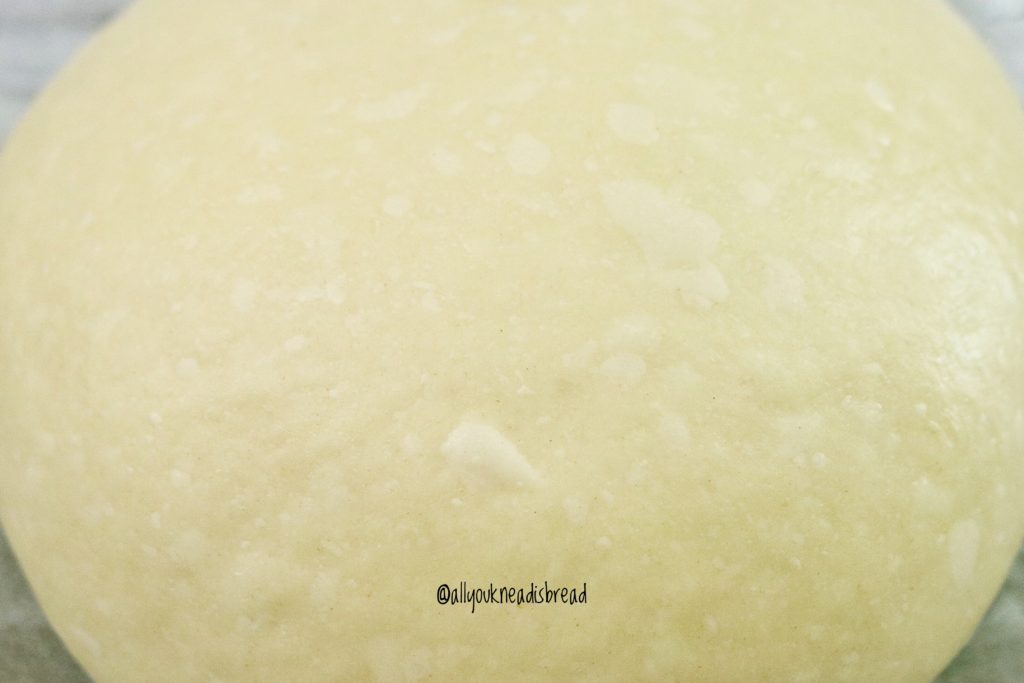
Let the dough ferment until it is puffy and has risen about twice its volume. Then deflate the dough and let it rest a few minutes before dividing it into 2 equal pieces.
This recipe yields 2 loaves. So, while you work with one piece, make sure you cover the other piece of dough well. You can even place it in the fridge to slow down the fermentation.
While the dough is fermenting you can make the filling.
Grind the nuts thin enough they will make a paste. Add the cardamom powder, milk, and orange blossom water. If you want it sweeter you can add sugar too.
Cook at medium heat until the nuts get a paste-like consistency. Turn off the heat, add the butter and stir. The butter helps the paste be creamier.
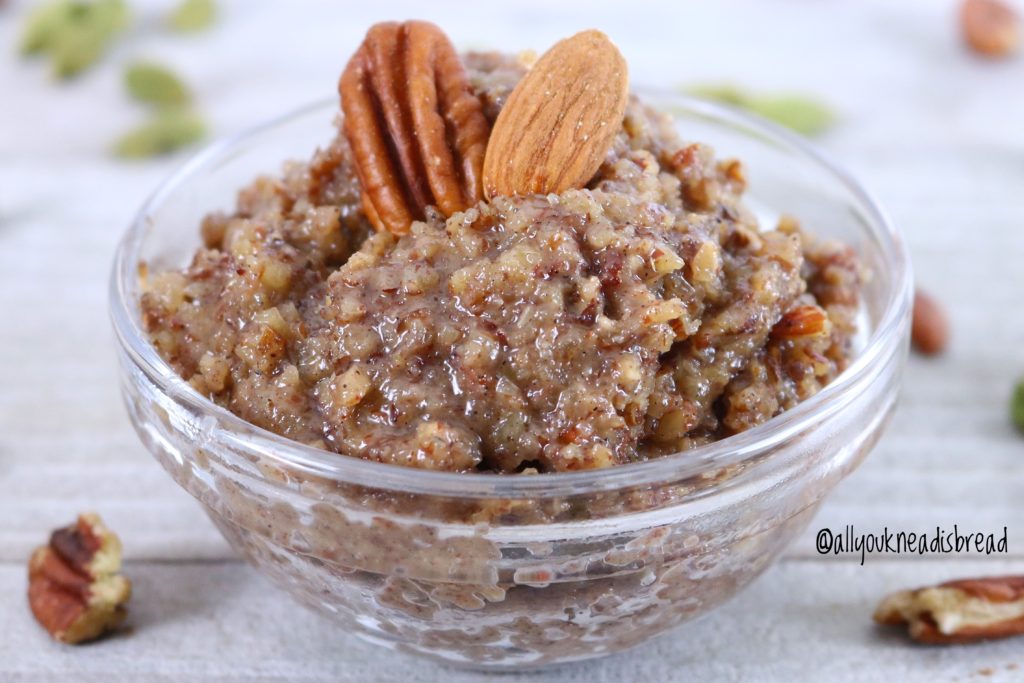
Transfer the paste to a plate and let cool to room temperature. Remember that if you add the filling while it’s too hot you can kill the yeast.
When the dough has risen enough flour your work surface lightly and roll the dough into 12 x 17 in rectangle. You can roll it into a longer length, the thinner you roll it, the more layers your babka will have, but the slices will fall apart easier.
Spread the filling on the dough and roll it into a log. Cut the log lengthwise and twist both strands leaving the open part up.
Grease your baking pan and place the babka in it. Let it rise until it reaches the edges of the pan.

Before the fermentation time ends, turn your oven on at 335F
Brush the babka with the leftover egg white and bake until it’s golden brown (about 45 mins, it depends on your oven). If the babka is not dark enough, you can bake it 5 minutes at 350F but be careful, the top can burn quickly!
After baking, babka is usually brushed with a simple syrup
If you want to make the syrup mix 2 tbsp of water and 2 tbsp of sugar and bring it to a boil. Cook until it reaches syrup consistency.
If you don’t want to make the syrup, I found a shortcut: Maple syrup!
Mix 2 tbsp of maple syrup and 2 tsp of water and mix very well.
When your babka is cooked, brush it with the syrup immediately, you can even pour the leftover syrup through the gaps. This will also help keep the moisture in the loaf.
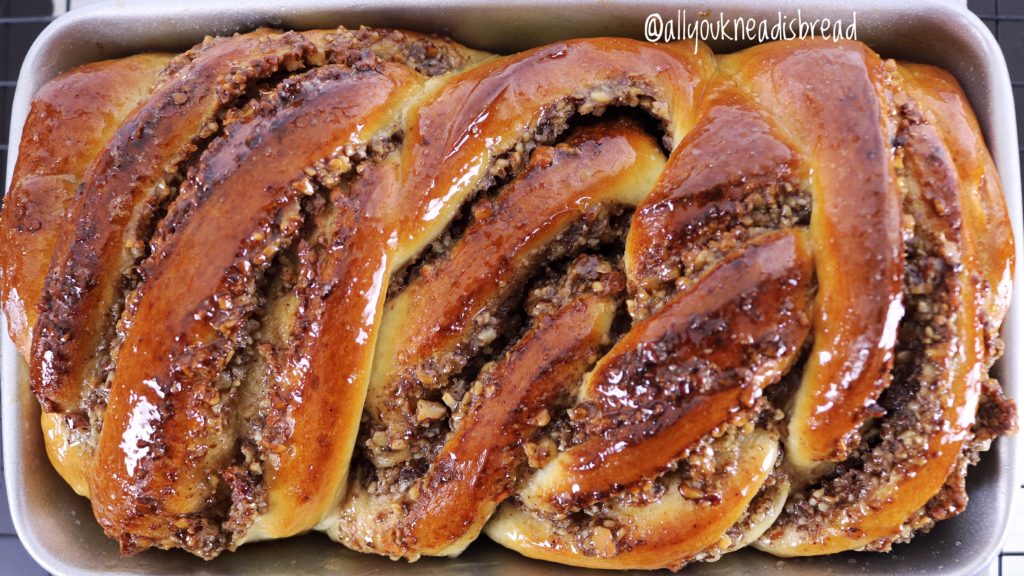
Let the babka cool down a few minutes in the pan an then transfer it to a cooling rack to cool completely… If you can wait that long!
The next step is to make a nice cappuccino an enjoy it with a slice of your babka!

Let me know what you think if you make this recipe and don’t forget to subscribe to my YouTube channel so you can receive a notification when I upload a video!
Enjoy!

Nuts and Cardamom Babka
Ingredients
Dough
- 500 g bread flour
- 225 g milk or vegetable milk
- 5 g dry yeast
- 80 g butter or dairy-free spread
- 2 L eggs
- 1 L egg yolk
- 50 g granulated white sugar
- 6 g salt
- 2 tsp vanilla extract
Filling (1 loaf)
- 200 g assorted nuts
- 70-100 g milk or vegetable milk
- 30 g sugar (optional)
- 2 tsp ground cardamom
- 2 tbsp orange blossom water
- 10 g butter or dairy-free spread (optional)
Instructions
Dough
-
Add the yeast to the lesser amount of milk and let it sit for 1o minutes to activate the yeast
-
Add the sugar, eggs, and vanilla extract and mix well
-
On a separate bowl sift the flour and add the salt
-
Add the flour to the wet ingredients, combine until you don't see dry flour particles, and let it rest 20-30 mins (autolysis)
-
Knead the dough until it's elastic, shiny and covered with small blisters. It should pass the windowpane test.
-
Let the dough ferment until it doubles in size and it's puffy
-
Deflate the dough well and divide it in 2 equal pieces
-
Roll one piece into a 12 x 17 in a rectangle. Spread the filling and roll the dough into a log
-
Cut the log lengthwise and twist each strand
-
Grease a 9in loaf pan and place the babka inside. Let it proof until the dough reaches the edges of the pan
-
Turn your oven on at 335F
-
Brush the babka with the leftover egg white and bake it for 45 minutes or until is golden brown
-
Prepare the syrup and brush it on the babka immediately after you take it out of the oven.
Filling
-
Grind the nuts in a food processor
-
Add the cardamom and sugar if you're adding any and stir well
-
Add the milk and orange blossom water and combine everything
-
Cook the nuts at medium heat until it gets a paste consistency
-
Add the butter for a creamier paste
-
Transfer to a plate and let it cool down to room temperature
Cheese and Cumin bread – Video

Hello friends!
Do you know when you buy an ingredient for a recipe, but you don’t have the recipe yet? That’s how this bread happened!
Strolling down the grocery store I found an English cheese and I knew I wanted to use it in a bread recipe. I could almost smell it! There are many recipes of loaves with cheese inside, breadsticks stuffed with cheese, etc. But I wanted to make something different.
In Spain, bread is always on the table and in my home, my parents always had a wedge of cheese. Every Friday evening, before dinner, my dad would slice some cheese and we’d all eat it with a piece of bread.
At that time, the local bakery started to make a new type of bread, it was called “torta de aceite”, it was a soft bread made with olive oil. The shape and texture were similar to focaccia, but without toppings and a more delicate crumb. We all loved that bread and we started to enjoy it every Friday evening with our cheese 😊
Then I thought… What if I make a similar type of bread with cheese on top? I was drooling just thinking about it.
I decided to add cumin seeds to this recipe because I also remember my parents used to buy a type of cheese with cumin seeds, and I loved that flavor combination! If you haven’t tried it yet, I encourage you to do so and see if you like it too. But if you don’t like cumin, you can skip it or change it by something you like better.

This bread has an intense aroma and is very soft, with a delicate crumb. You can use it to accompany meals, or as an appetizer, or even as a snack on a Friday evening 😊
The egg and olive oil add fat to the dough and this allows the bread to be very soft and last fresh for several days, although I doubt it’ll last too long!
So, without further ado, let’s get to the recipe!
First, as always, we need to activate the yeast. In this case, I added some sugar to feed the yeast.
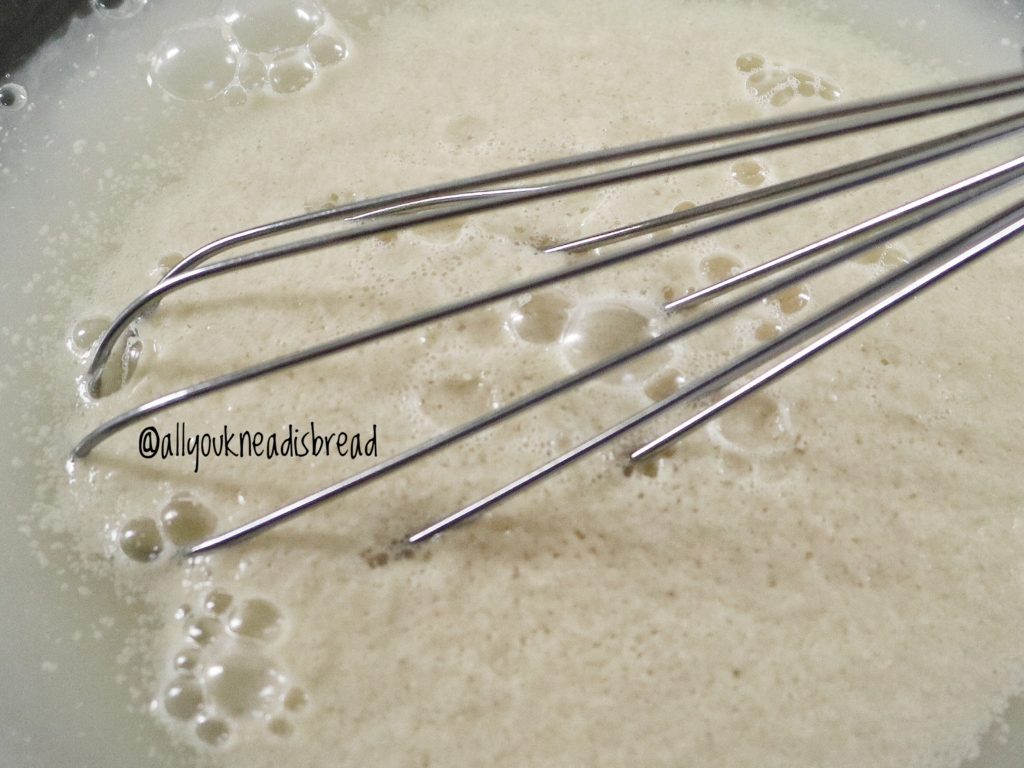
Then we mix in the egg and cumin seeds and combine very well.
NOTE: you can add the oil to the wet ingredients now, I prefer to add it later because I think the crumb turns out spongier. But that’s my preference. Just make sure you knead the dough well.
Now we let the dough hydrate for a few minutes before we start kneading.

Add the oil and incorporate it very well. Then knead the dough until it’s soft, elastics, and shiny.

Let the dough rise until it has doubled or tripled in size

Deflate the dough well and let it rest 20 mins.
Shape the dough. You can shape it into a circle, a rectangle… whatever you prefer!
Cut the cheese and put it on top of the dough. I used an aged cheese, and that’s what I’d recommend. I wouldn’t use shredded cheese because: 1) it’ll burn and 2) it doesn’t have the strong aroma of aged cheese.
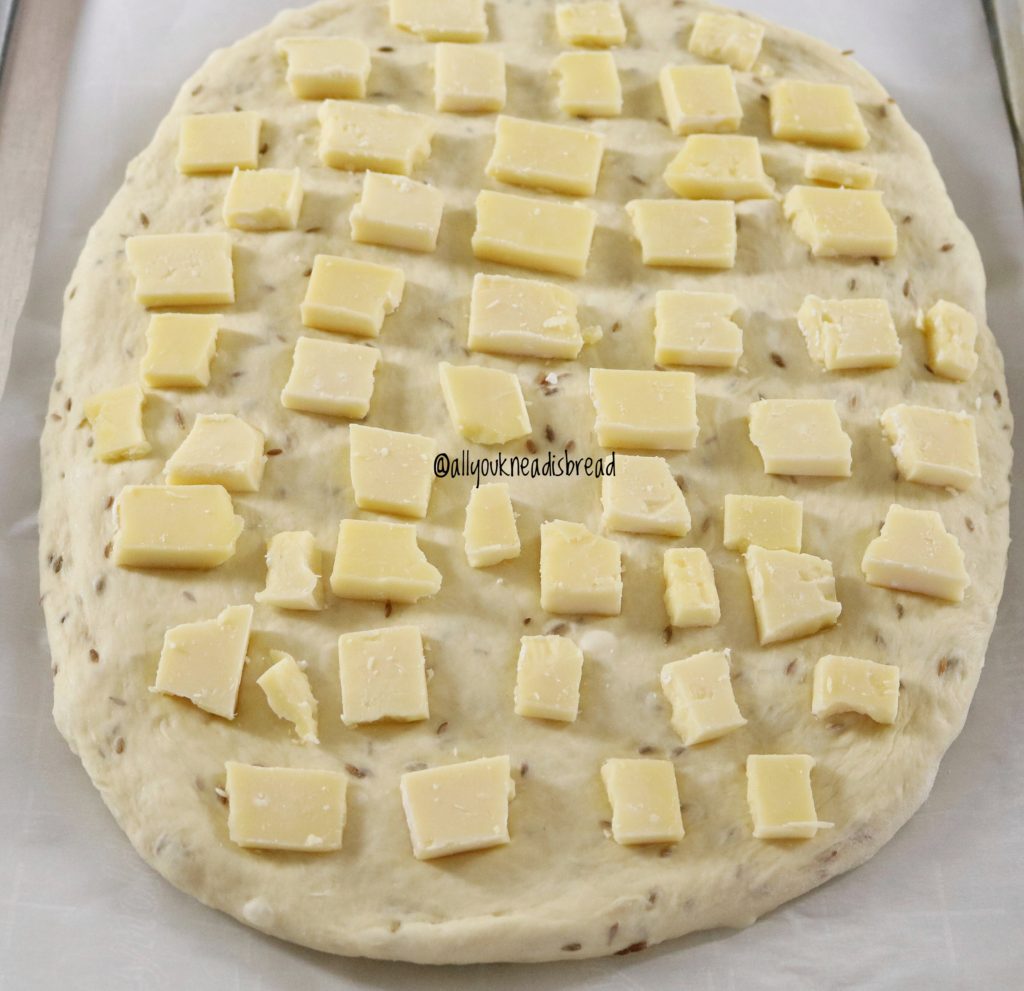
NOTE: if you prefer a flatter bread, shape it thinner and make sure you pierce large air pockets.
Cover the dough with a clean cotton cloth and preheat your oven at 360F for about 20 mins
This will be the time we’ll let the dough rise, when the oven is ready, brush the bread with egg wash and bake it for 30 mins or until it’s done and has a deep golden brown color.
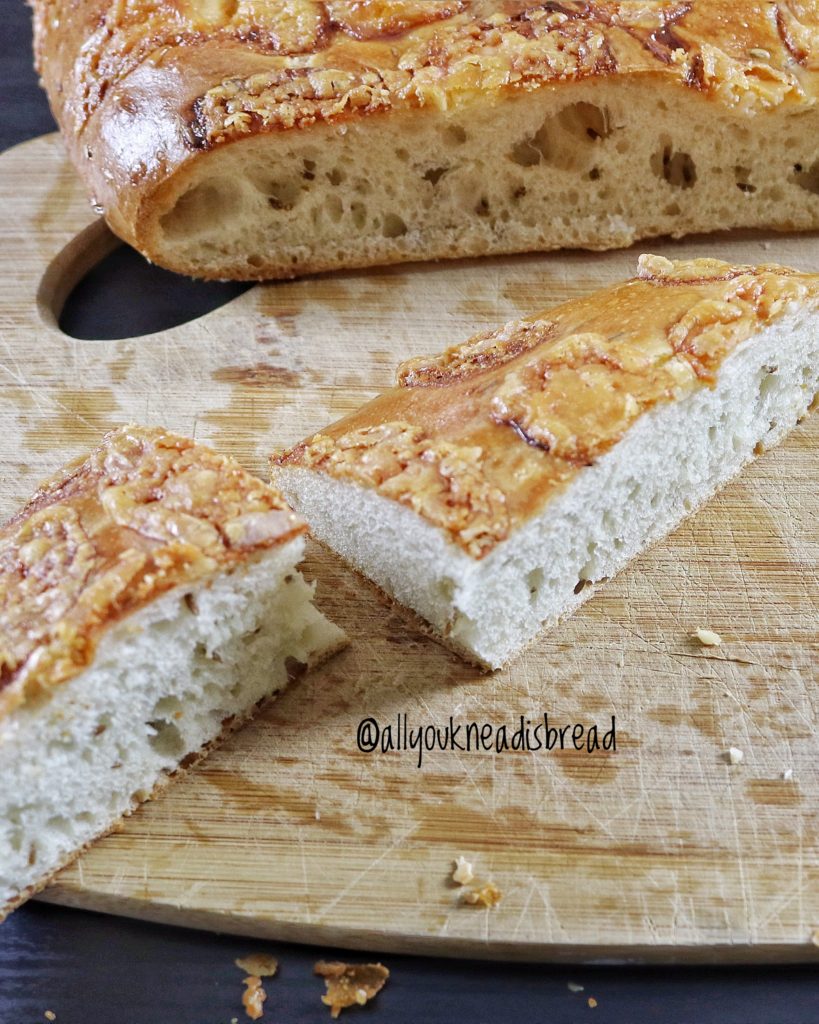
Your kitchen is going to smell heavenly!
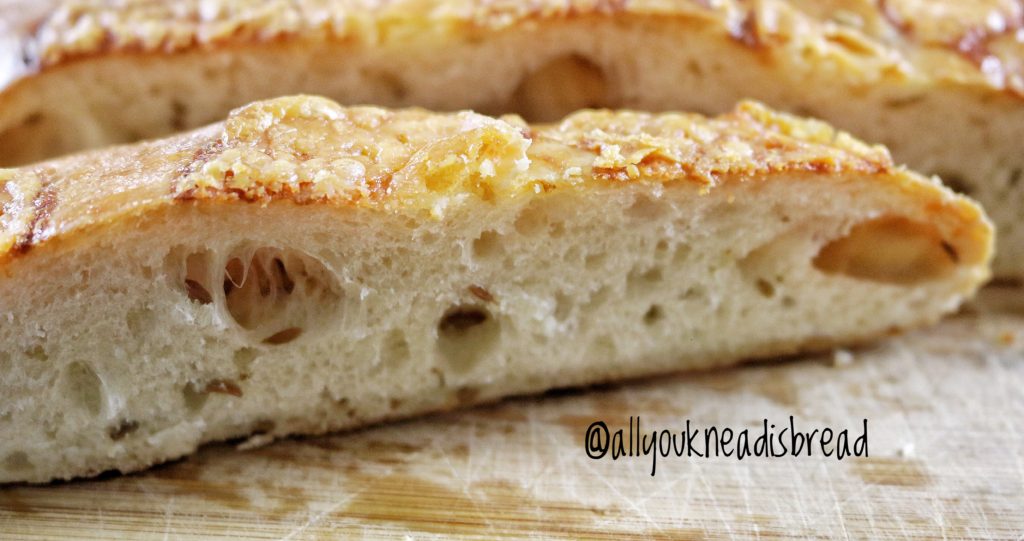
When the bread is ready let it cool down on a cooling rack… If you can!
Let me know what you think about this recipe and if you like it, thumbs up on the video and subscribe to my channel!
Happy baking!

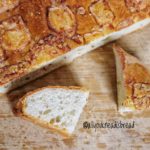
Chese and cumin bread
Ingredients
- 450 g bread flour
- 250 g water
- 5 g active dry yeast
- 1 egg L
- 1 tbsp sugar
- 7 g salt
- 40 g olive oil extra virgin for a more intense flavor
- 5 oz aged cheese
- 1 tbsp dry cumin seeds
- 1 egg for egg wash
Instructions
-
Dissolve sugar in water, add the yeast and whisk it together. Let it rest 5-10 mins
-
Add salt, egg and cumin seeds to the yeast mixture and combine well
-
Sift the flour into a bowl and add the wet ingredients
-
Combine all ingredients until you don't see dry flour particles and let it rest for 20-30 mins
-
Add the oil and incorporate
-
Knead until the dough is elastic, shiny and full of blisters and let it ferment until it doubles in size
-
Deflate the dough well and let it rest a 15 minutes before the final shape
-
Cut the cheese block into thin pieces
-
Preheat your oven ar 360 F
-
Shape the dough into a 1/2 inch oval and place the cheese bits on top
-
Let the dough ferment while the oven preheats
-
Brush with egg wash and bake for 30 mins or until it's golden brown
Brioche with sourdough discards

Hello friends!
I hope you’re having a wonderful summer! I’m definitely enjoying my well-deserved break! Since I have time, I’m baking almost every day. Nothing makes me happier than having fresh bread on the table!
I’m also taking this time to look for new recipes, try flavor combinations… And also, to look into how bread science can help your baking.
Lately, I’ve seen several brioche recipes and from the pictures, I could tell that the crumb wasn’t what brioche crumb should be. In other words, most likely, the dough wasn’t developed properly.
Why is brioche usually labeled as a “difficult” bread to make? Well, adding solid butter is challenging, and developing dough with that amount of fat takes extra time. So, it’s easy to give up
But let me tell you something, brioche = patience, that’s it. That’s the secret.
Sometimes we’re tempted to melt the butter and make the whole process easier
Or we stop kneading because we’re just tired of waiting for the dough to be ready…
Both butter and kneading, are strongly related when we make brioche.
On this post, I explain why we should use solid butter and how to knead brioche to achieve the PERFECT texture.
I hope that once you understand the science behind, it’ll be easier for you to achieve better results and not to get discouraged when handling enriched dough.
Also, on this recipe, I show you a way to use sourdough discards.
If you’re beginning your brioche journey, this recipe is for you because the butter content is not too high. Practice with this recipe and feel free to increase the amount of butter later on.
This is not a 100% sourdough brioche, it also has commercial yeast. But the sourdough enhances its aroma, and the long fermentation times improve its texture considerably. Speaking of texture….
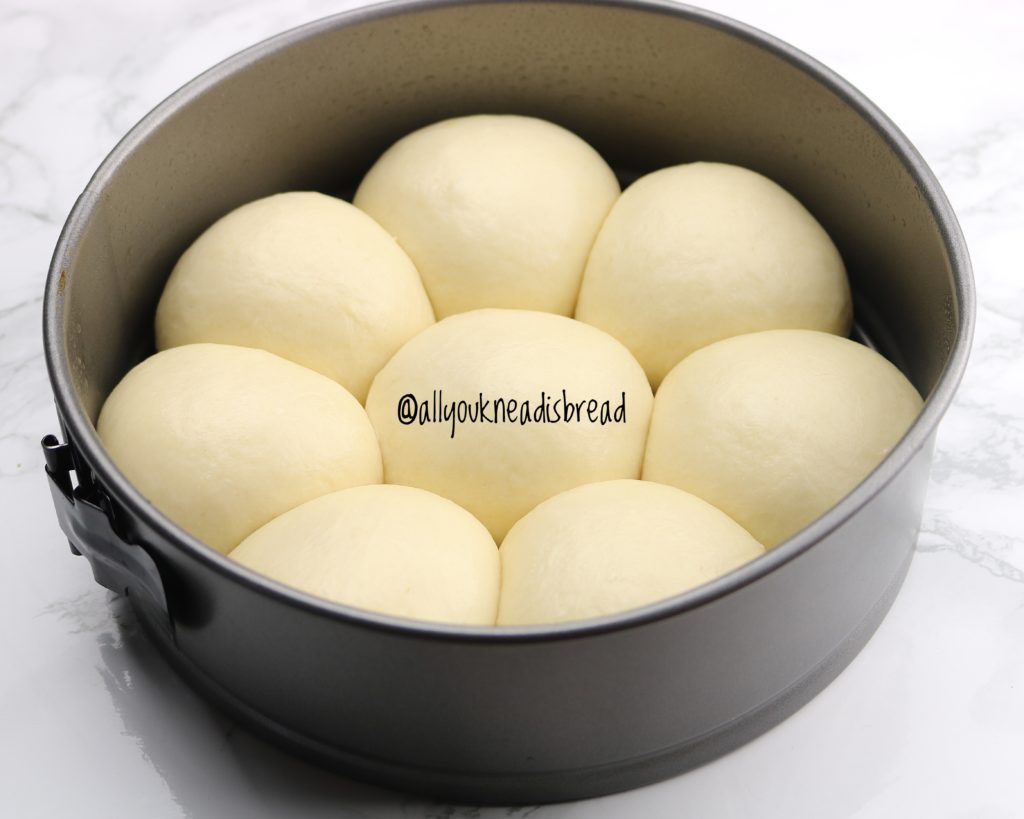
How to get the best texture in your brioche
First things first. When making brioche we need to have one thing in mind: the fat content is very high, not just because of the butter, but also the eggs, therefore, developing the dough is going to take time and patience.
Although this brioche has a relatively low flour:butter ratio, all the explanations apply to higher butter content brioche and other enriched doughs.
How does fat affect the dough?
The first thing you need to know is that melted butter and softened butter (which is still in solid-state) are two completely different things.
The structure of solid butter is made of little crystals that interact with other ingredients and are essential for developing a nice gluten network. When you melt butter, those crystals are destroyed, so the structure of the butter is different, therefore, the way it interacts with other ingredients it’s also different.
Although the role of solid fats is not fully understood yet, scientists have agreed in a three-parts mechanism to explain what happens when we add butter or shortening to bread dough:
- Wheat proteins have bound phospholipids in their structure which are essential for gluten elasticity. These lipids interact with the crystals found in the butter to create gluten-fat complexes (structures) that strengthen the gluten network and give it more elasticity.
- Butter (or solid fats) can act as a lubricant between the gluten structure and starch matrix, improving the gas retention capacity of the dough. As a result, dough that has a higher content of solid fat has the ability to rise more due to an improved gas retention capacity.
- Solid fat melts during baking and seals pores that are present in the dough through which the gas would, otherwise, scape. CO2 eventually leaves the dough, but the butter retards this process and, again, helps the expansion of the dough during baking, the famous “oven spring”.
You can see that a proper redistribution of the fats within the dough is very important. And the way to achieve it is…. By kneading! Of course 😉
How to knead dough with high-fat content
Developing the gluten network of enriched dough consists of two major steps: One is the development of the gluten-starch matrix the other is the development of the gluten-butter complexes.
First, we need to develop the gluten-starch matrix, so then, the butter has a place to start forming the complexes I mentioned before. That’s why we don’t add the butter at the beginning, we knead the dough a little bit until it has a good consistency.
After that is when we start adding the butter.
Think of it as building a house. First, you need the main structure, then you start building up the walls.
However, how many times have you tried to develop the dough and it looks as it will never come together?
That’s because the long strands of gluten proteins, as they form, they get all tangled. If you force them too much (knead too much) you might end up breaking them, or in other words: over-kneading the dough. There’s a simple solution though… Let the dough rest!
Letting the dough rest while kneading can go a long way and reduce the kneading time. Whenever you have troubles to bring the dough to full development stop for 5-10 minutes so the gluten strands have time to detangle.
What do you achieve with this?
- You avoid over-working the dough having better control over it.
- You can develop a better gluten network, with organized gluten strands that are more elastic. This will improve the cohesiveness and strength of the final product. The crumb of your bread will be AMAZING!
- You avoid increasing the temperature of the dough to the point where the fats will melt. Either if you’re using your hands or a stand mixer.
The texture of your brioche should NOT look like cake or banana bread. It should NOT be crumbly. It should be cohesive, soft, spongy and springy. You should be able to pull apart strands of crumb. If not, most likely, the dough wasn’t properly developed
Although there can be many other reasons to explain why the texture didn’t come out right, I believe dough development is, usually, the main cause.

As you can see, breadmaking is pure science. And I hope that by understanding better what goes on when you mix the ingredients, you can succeed and make better and better brioche!
And now… let’s go to the recipe!
For this brioche, I wanted to play with aromas a little bit because one of the loaves was going to be a gift. So I added blossom water, orange syrup, and lemon zest. But feel free to skip these ingredients or add other you like better
POSSIBLE SWAPS
- If you don’t have sourdough starter, just add half of the weight in milk or eggs and the other half in flour. You can also make the day before “pâte fermentée” (also known as old dough).
- If you don’t have orange syrup you can substitute if for honey, molasses, agave… Whatever you have at home.
- If you don’t have lemons, you can add any other type of citric zest.
- If you don’t have orange blossom water, you can add orange juice or brown liquor (rum would give a really nice aroma).
DAY 1 – Late Afternoon
In the morning I fed my starter to bake a sourdough loaf, I always make more than I need just in case! So, I use some for the loaf, some to keep and the rest… I used it in this recipe.

I started mixing my ingredients at 3 pm.
First, I mix all the wet ingredients and the sourdough discards to dissolve them a little. Then add the sugar and the yeast, combine everything well and let it rest a few minutes.
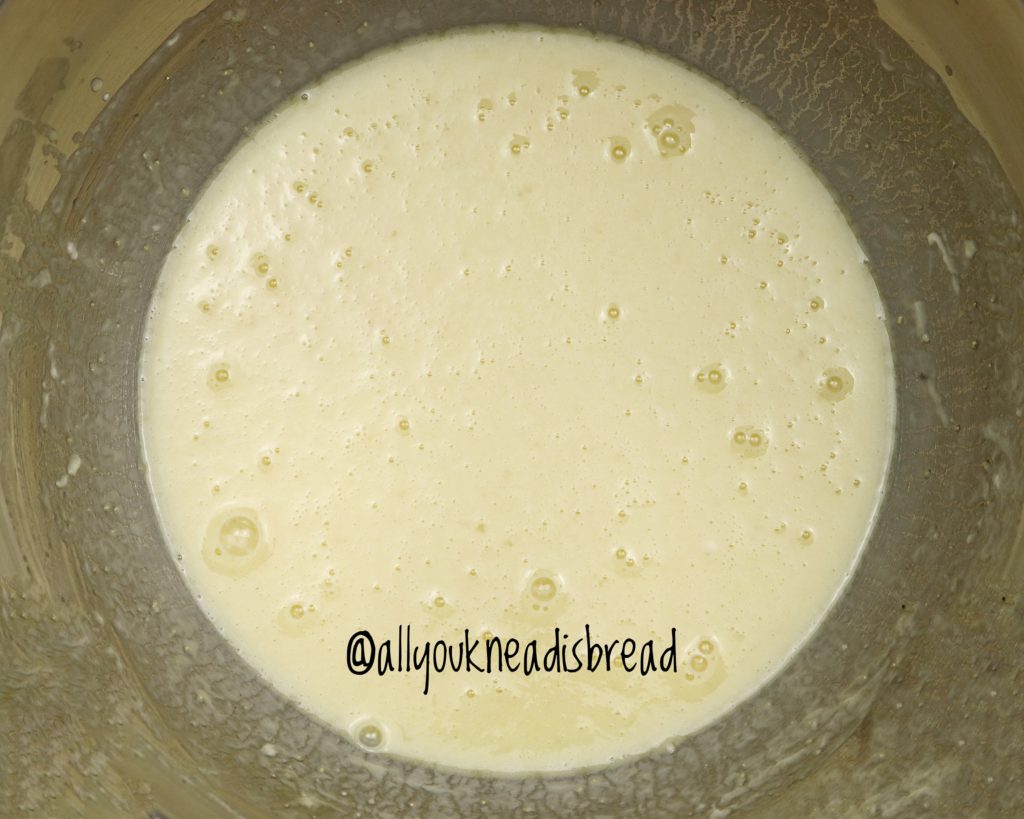
Sift the flour and add it to the wet ingredients along with the salt and lemon zest. Mix everything until you don’t see dry flour particles and let it rest for 20-30 minutes to allow the hydration of the flour.
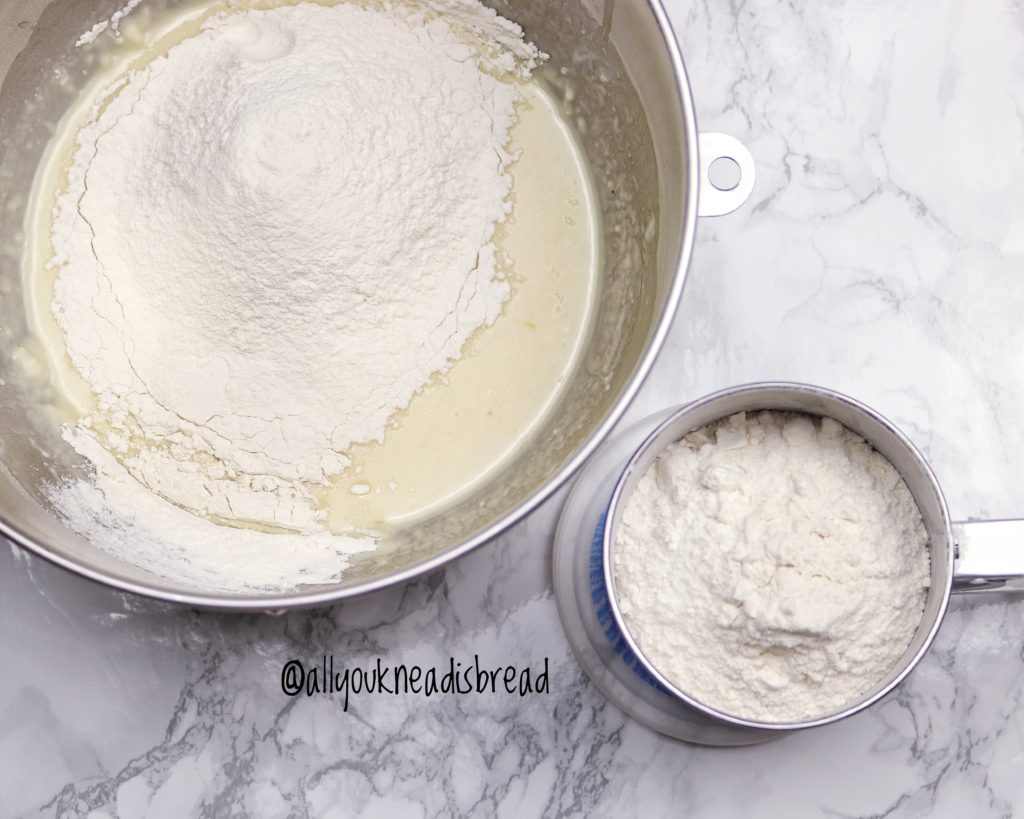

After the autolysis period, start kneading the dough until it reaches certain consistency.
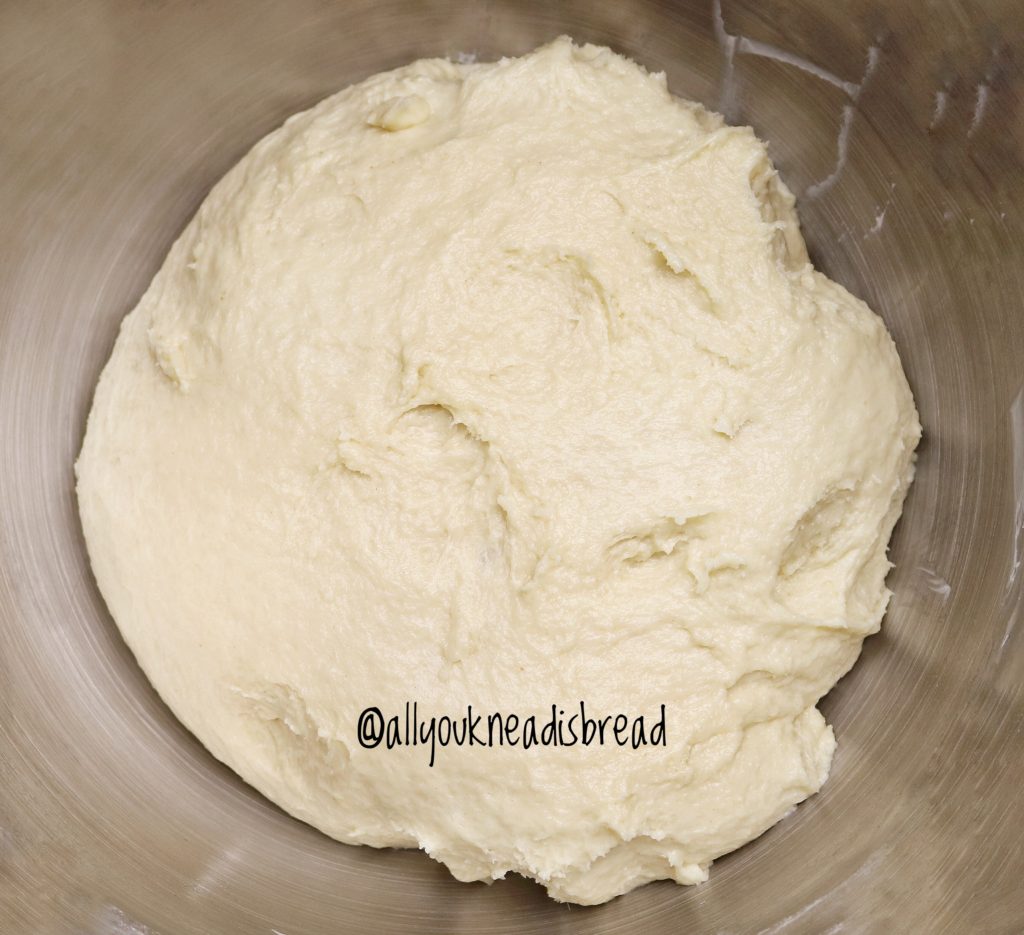
Start adding butter little by little. It’s better to use it at room temperature (softened butter) so it can be incorporated easier. Otherwise, you might have chunks of butter in the dough and it will be difficult to incorporate it.
I find easier to incorporate the butter by hand, what I do is squeeze the dough and twist it until the butter is absorbed. You can see how I do it on my Belgian waffles video
Then continue kneading the dough at low speed. After 15 minutes stop, cover the bowl and let it rest for 5 minutes. Knead again for another 10 minutes, stop and let it rest for 5 minutes. Continue again for another 10 minutes, stop and let it rest 5 minutes.
At this point your dough should be almost ready, it should start coming up the dough hook of your stand mixer and separating from the sides of the bowl. After this last resting period, keep kneading until the dough is ready, it shouldn’t take much longer.
If you live in a cold and dry environment, you might need more time. So pay attention to your dough, let it tell you what it needs 😊
It took me almost 50 minutes to have the dough fully developed (without resting time).

A fully developed dough should not be sticky, should come out of the bottom of the bowl without tearing and should pass the windowpane test.
To check the windowpane test, let the dough rest a few minutes first. Otherwise, you coul have a “false negative”. The dough could tear because the gluten strands are tangled, not because they’re not ready.
When your dough is ready, let it ferment at room temperature until it almost doubles in size, after that, put in the fridge, and leave it there overnight. Mine was in the fridge for 18 h
Turn the dough onto your work surface and deflate it. Be gentle, but make sure there aren’t big air pockets.
This recipe yields one 9 in (22-23cm) springform pan and one 9.75 x 6 in (25 x 15 cm) loaf pan. If you just want the brioche in the circular pan, multiply all the ingredients by 0.75
Separate 8 pieces of 130-140 g each and shape them into balls and place them into the pans. Then shape the rest of the dough in 4 logs as wide as your pan or 2 longer logs and cut them in half (this is what I did 😉)
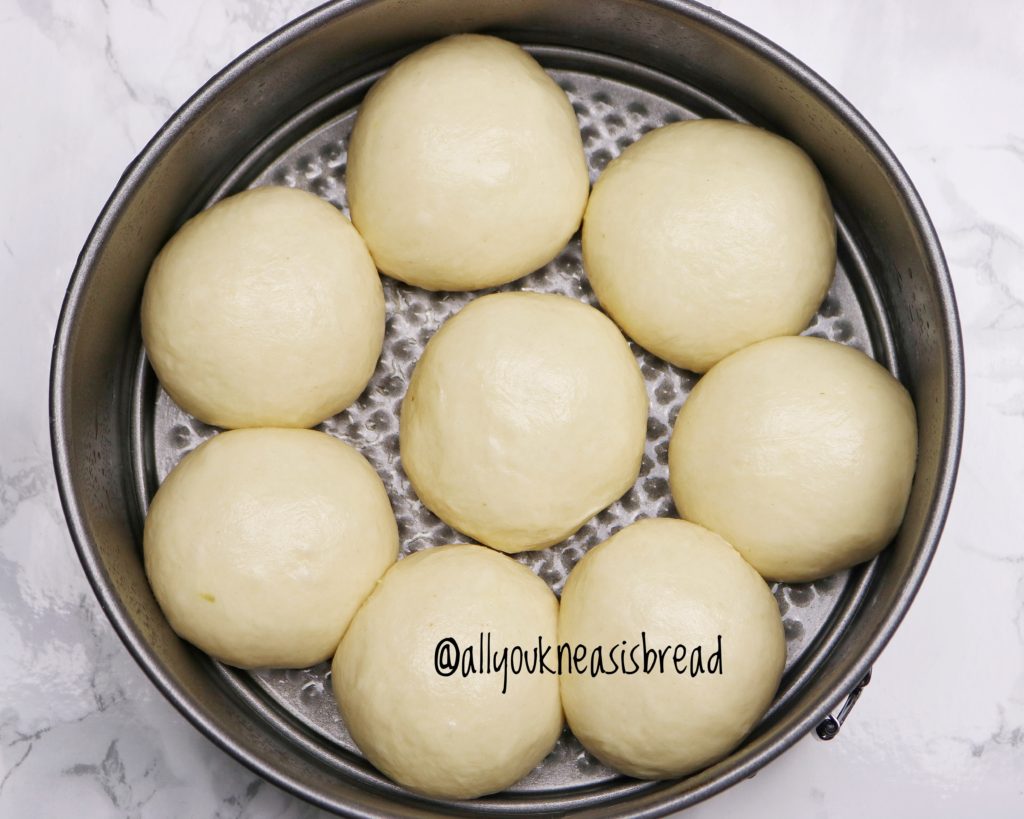
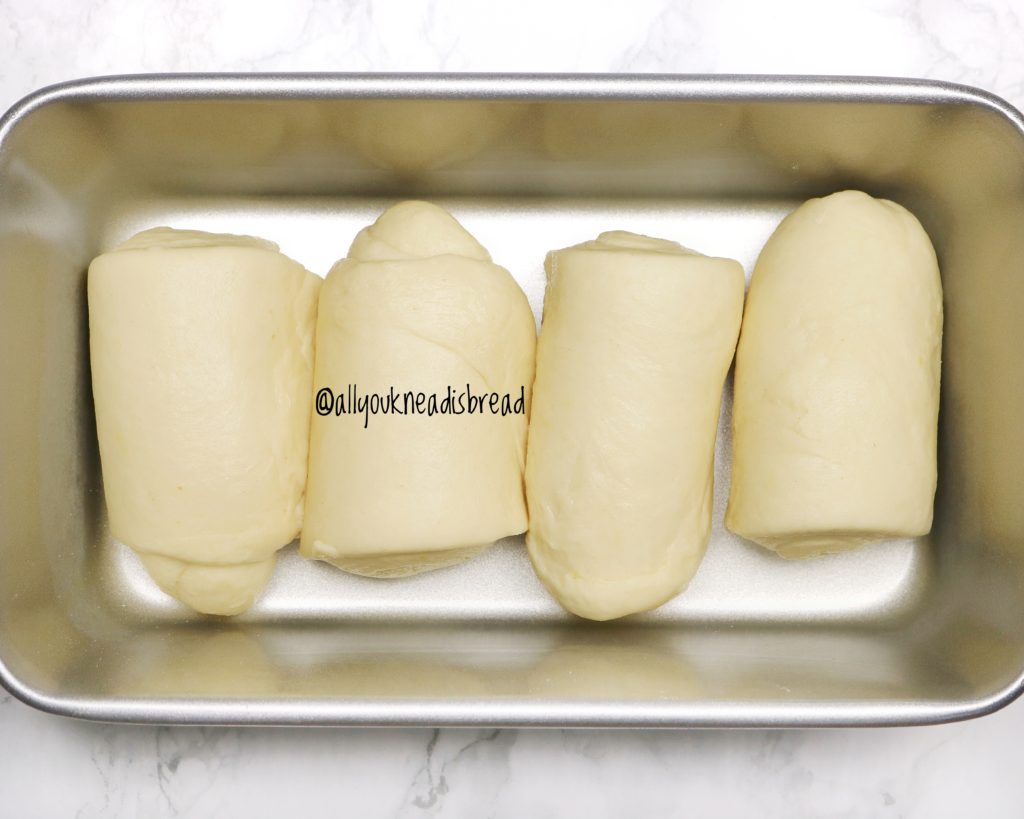
And now time to wait! Let the dough rise until it’s puffy; if you poke it with your finger, the dough will spring back but not immediately. That means the dough has enough gas trapped inside. Sometimes, the dough can be ready but does not necessarily double its size.
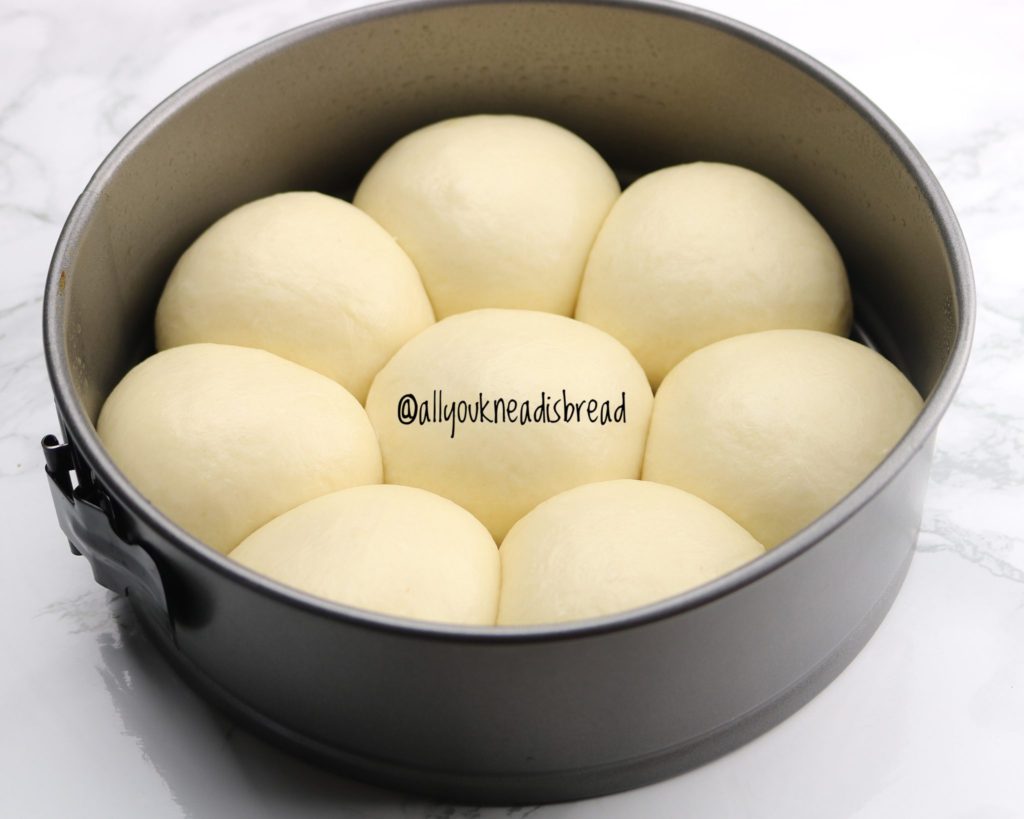
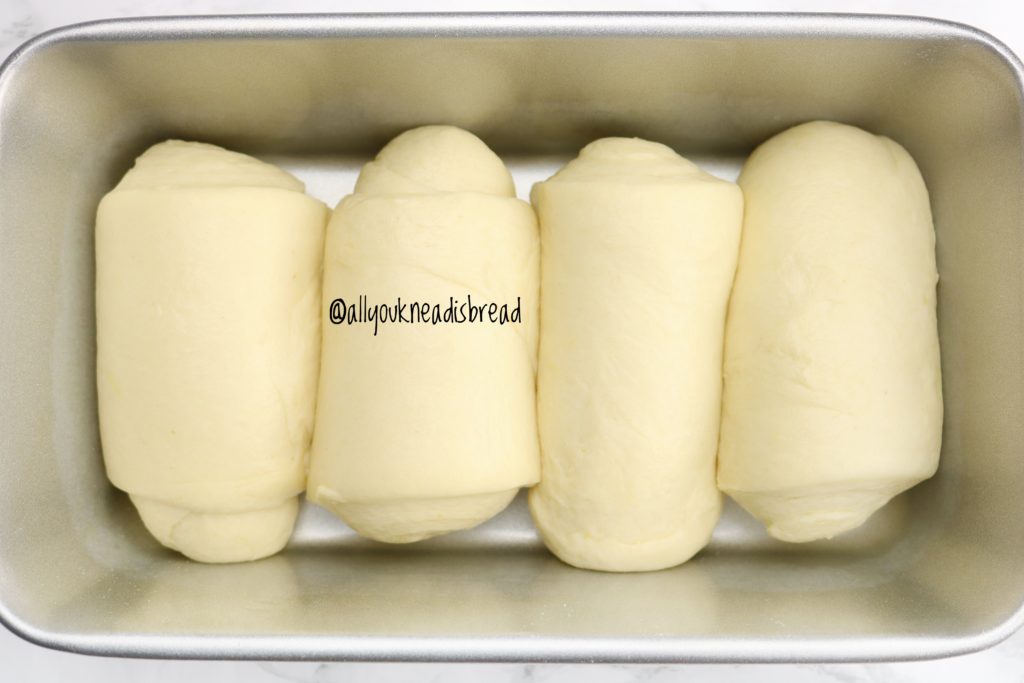
20 minutes before the brioche is ready, preheat your oven at 350 F (175 C)
Before baking, brush the brioche with egg wash. I like to use an egg yolk and a Tbsp of milk. This egg wash helps soften the crust and the brioche it’s like the one you buy in the store, but better because you made it!
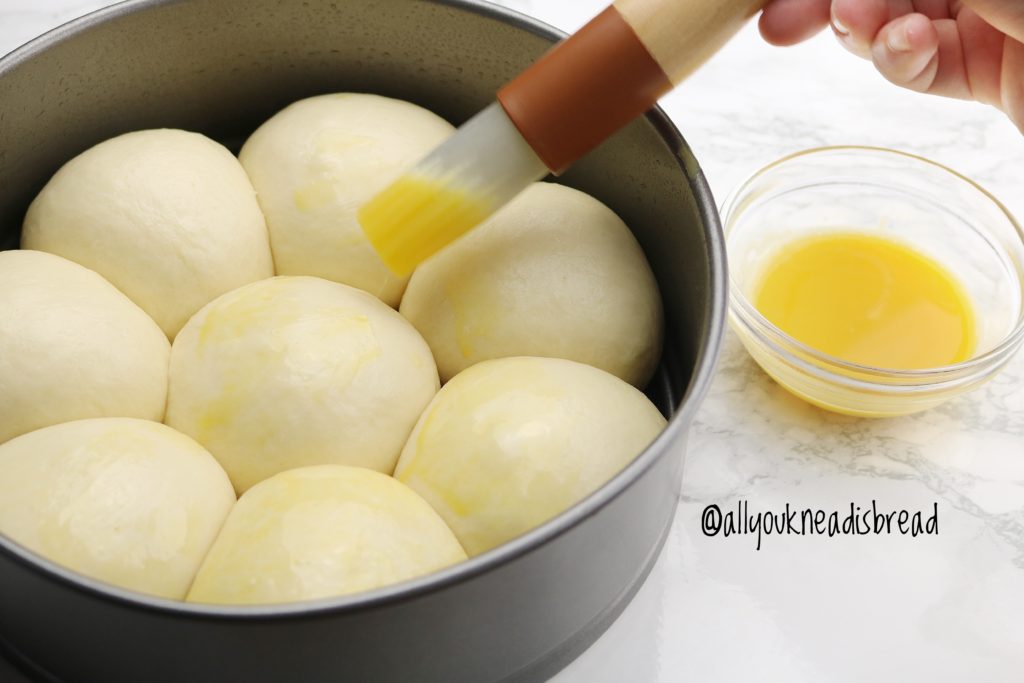
Bake the brioche for 30 – 40 mins, keeping an eye on it. Bake it until it has a nice golden-brown color.
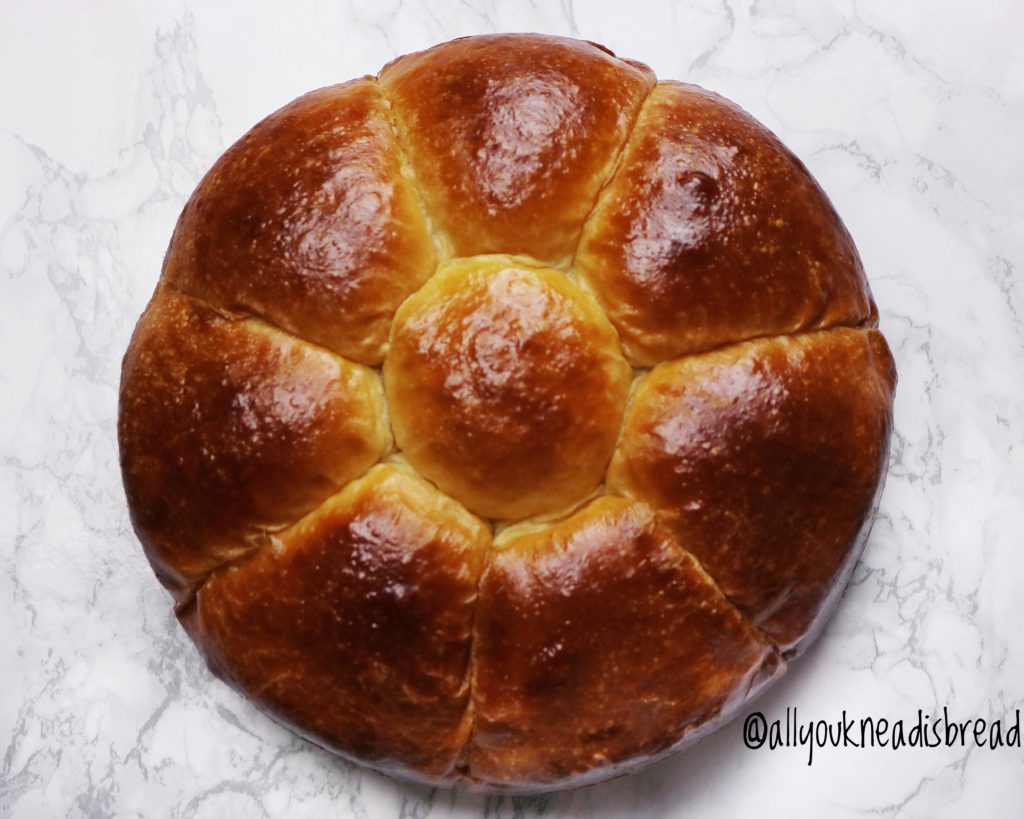
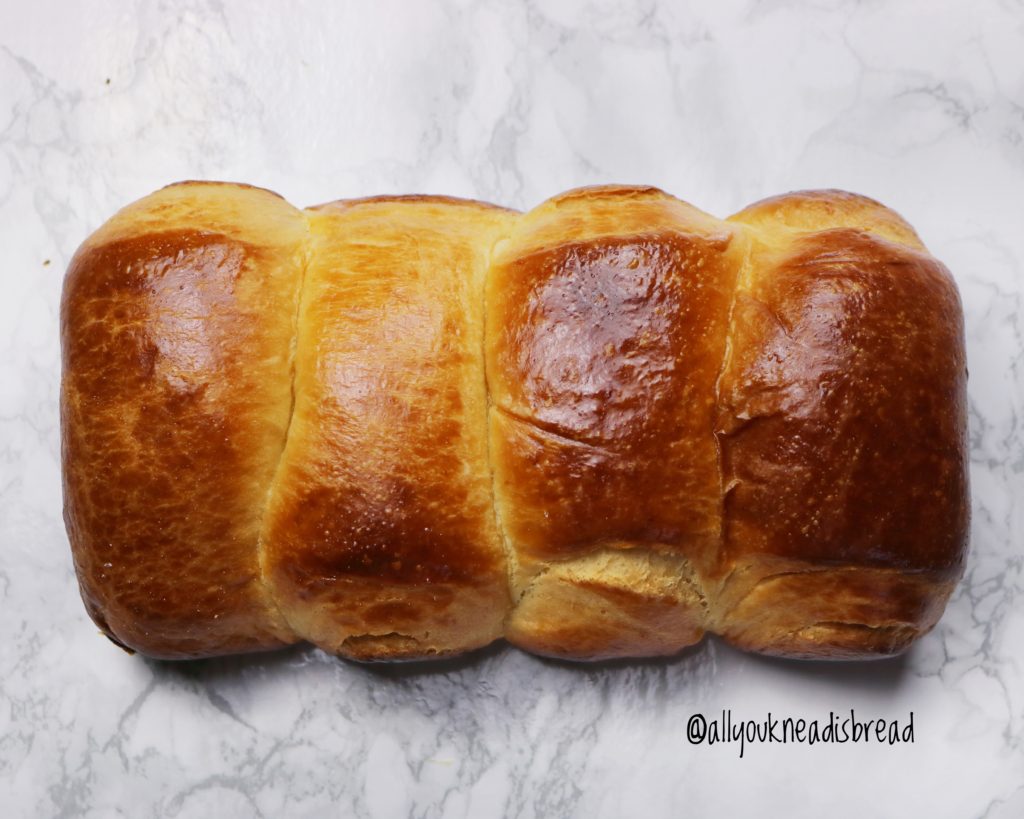
Before you dig into this tasty treat, let the brioche cool down to room temperature. This step is very important because to let the crumb finish baking, set aromas, etc. But after it cools down… oh boy!
If you can see these strands, you worked the dough well. The gluten was properly developed, the fats were successfully incorporated, and the structure of the baked brioche is very cohesive.



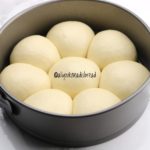
Brioche with sourdough discards
Ingredients
Dough
- 500 g bread flour
- 2 eggs large
- 140 g milk
- 160 g 100% hydration SD starter
- 4 g active dry yeast
- 100 g sugar
- 5 tsp orange blossom water
- 2 tbsp orange syrup optional
- zest of 2 lemons
- 10 g salt
- 1 ½ sticks unsalted softened butter
Egg wash
- 1 egg yolk
- 1 tbsp milk
Instructions
Day 1 – late afternoon
-
Thaw 160 g of your sourdough starter (if you keep it frozen) or take 160 g a few hours after you fed your starter.
-
Add the eggs, milk, sugar, salt, dry yeast, orange blossom water, orange syrup, and your starter to your stand mixer bowl and give it a good whisk.
-
Sift the flour and add it to the wet ingredients. Combine until there are no dry flour particles.
-
Let the dough rest for 20-30 minutes to allow the flour particle to hydrate.
-
Start kneading the dough at low speed for about 10 minutes or until the dough gets a bit elastic
-
Add the butter in 3 or 4 batches, making sure it's completely incorporated before you add the new batch.
-
Knead the dough at low speed until it's very elastic, shiny, the surface has blisters and it's not sticky. You shouldn't need to add more flour. It should pass the windowpane test
-
Cover the bowl and let the dough rise at room temperature until it doubles in size
-
Place the dough in the fridge for a cold fermentation for at least 15 h. You can leave the dough in the fridge for up to 2 days
Day 2
-
Remove the dough from the fridge and gently deflate it. Cover it and let it rest for 10 minutes
-
Take 8 pieces of 130 – 140 g (4 – 5 oz) from the dough in equal pieces, shape them into balls and place then into your round baking pan.
-
Divide the rest of the dough into 2 equal pieces, flatten them with your hands and with a rolling pin roll them into a rectangle twice as wide as your rectangular baking pan.
-
Make a log with both pieces of dough, with a knife or a bench scraper divide them into equal halves, and place them in your rectangular baking pan.
-
Cover the two pans and let the dough rise to the rim of the pans.
-
Preheat your oven at 350 F
-
Before baking, whisk the egg yolk and the milk together and brush the brioche with it.
-
Bake the brioche for 45 minutes or until it's golden brown
-
For best results, let the brioche cool down to room temperature before cutting through it.
Recipe Notes
- Let the dough rest for 5-10 minutes before performing the windowpane test.
- You can shape the brioche in any way you prefer. Just make sure that the dough fills half of the container you use.
Happy baking!

Russian Kefir Bread – Video
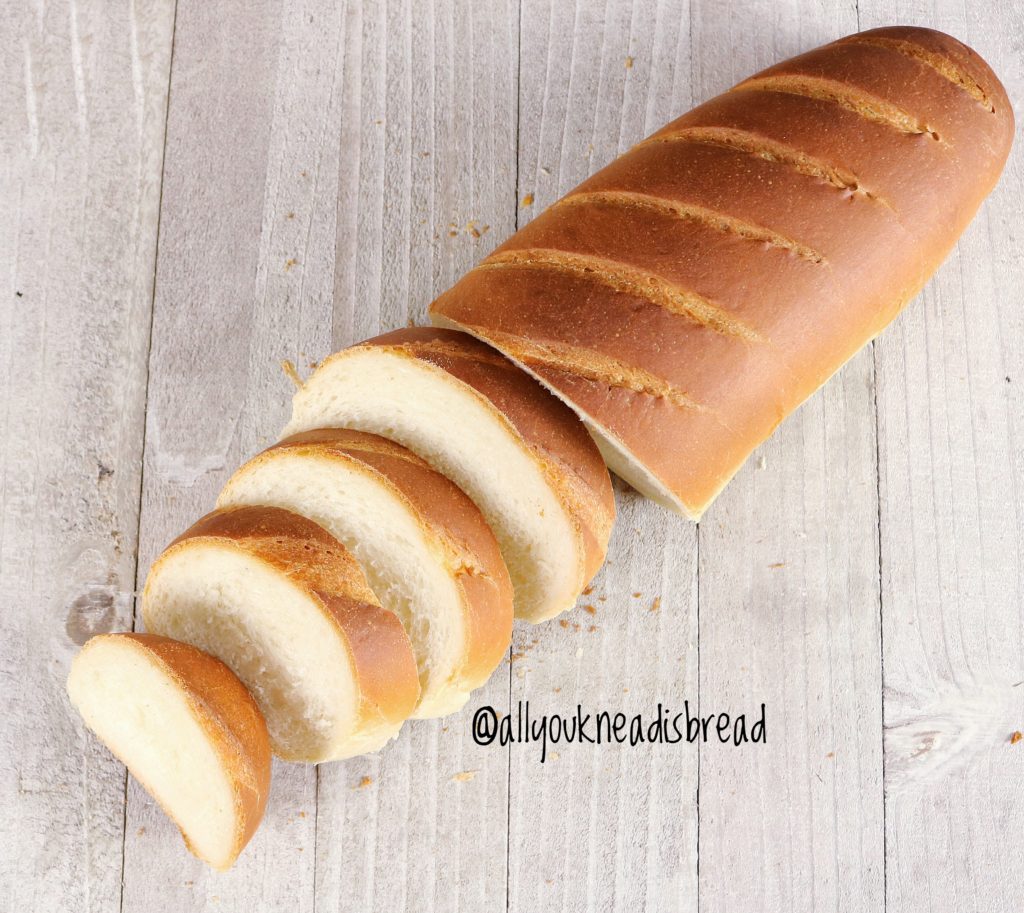
Well well well… Looks like summer is already here! One of the things I like of the crazy weather we have in NC is the summer storms. I find rain quite relaxing, the trickling sound of the water, the smell of wet soil, the sunset of a stormy day… And baking while raining? That’s a complete spa day!
I guess many of you will go on a vacation this summer, but if for some reason you won’t, I’d like to take you on a little trip without leaving your kitchen! I’d like to take you to the Caucasus region!
This region is well known for their kefir. A fermented milk drink made from kefir grains. These grains are a combination of yeasts and bacteria that you add to milk. The culture ferments overnight, and the next morning you have your fresh fermented drink! The consistency is similar to drinkable yogurt. A little bit sour because of the lactic acid bacteria. While I’m not an expert on homemade kefir, I believe you can control the sourness by controlling the fermentation temperature and times.
Kefir has gained much attention in the last years because it’s a probiotic, so it’s very healthy for your gut microbiota and digestive system. Now you can find it in almost all grocery stores!
I came to realize that almost every country and region have a bread recipe that uses local ingredients or cooking techniques, so in Eastern European countries, kefir is sometimes used to make “батон” (baton) bread. I guess the name comes from the shape of the bread.
I’ve been doing some research on this recipe, I’ve looked for blogs and videos (Thank you Google translate!) and I finally found a recipe that I like, although I’ve made a few changes.
This bread is very easy to make and it the perfect candidate to start kneading by hand. This dough is on the dry side, therefore comes together pretty fast. It’s great to try different kneading techniques and develop your own style. I think making this bread can also be an excellent activity to do with your kids, the recipe it’s simple, they can help you knead, and they won’t make a mess because the dough is not very sticky! 😉
You can eat this kefir bread with savory dishes, or jam, or just plain! And it makes wonderful French toasts too! The flavor is rich and delicate, and the kefir really gives the bread an interesting kick and aroma! The crumb is perfectly fluffy and cohesive, and the crust is not too thick, so you can use this recipe to make homemade subs! The crust will get softer after a few hours. And in my opinion, the aroma of the bread is better after it cooled down completely.
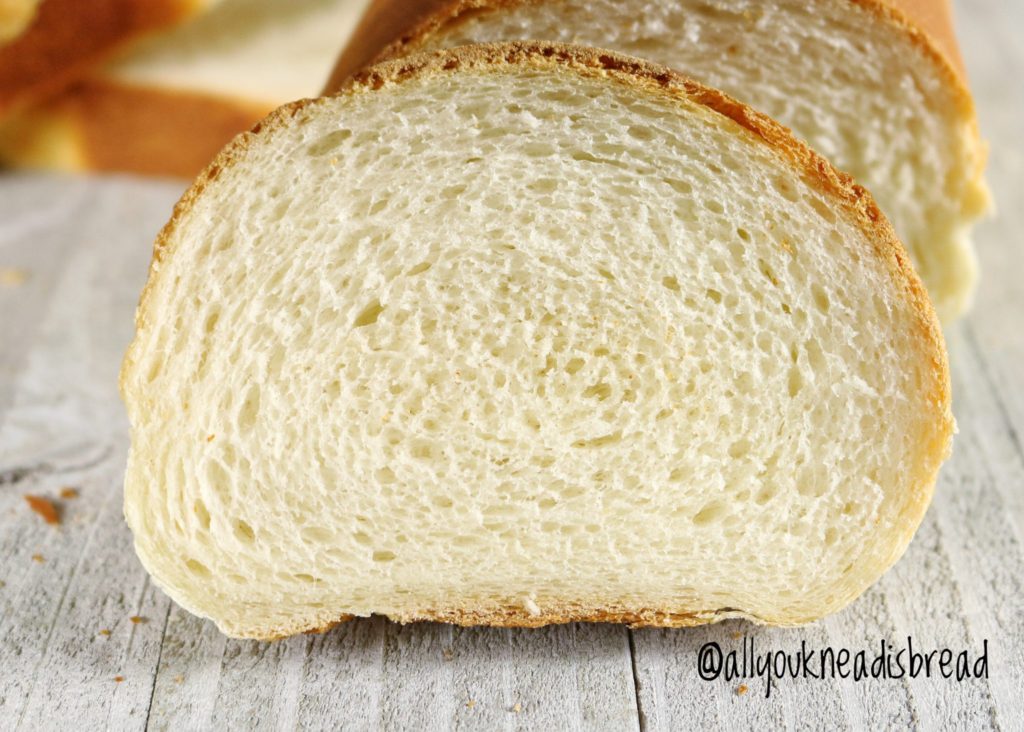
The recipe yields 3 large loaves or 4 medium loaves, so if you’re not going to eat them all you can freeze some and keep the rest in a Ziplock bag for a few days.
Let’s start with the recipe!
As always, activate the yeast in the water and let it sit for a few minutes.
Once the yeast is active, add sugar, salt, kefir and butter and give it a good whisk. Don’t worry if there are chunks of butter.
Then add 1/3 of the flour and combine everything very well until you have a thick paste. By doing this, incorporating the butter will be easier and you don’t have to melt it. Bread usually turns out better if you don’t melt the butter.
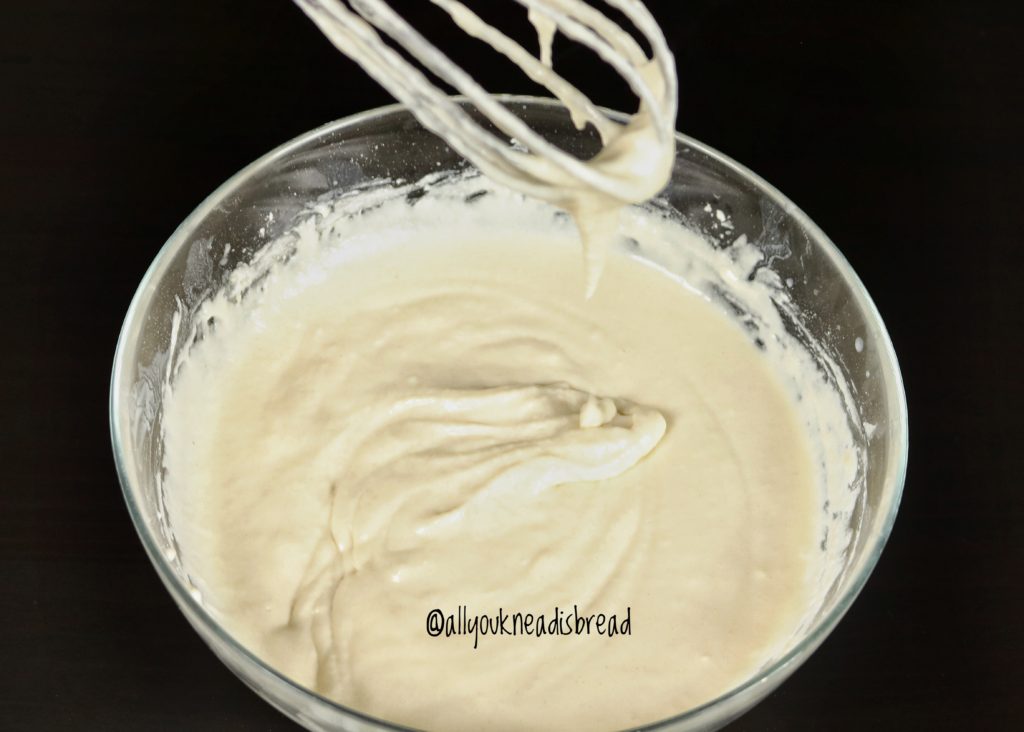
Add the paste to the rest of the flour (previously sifted) and combine all the ingredients together until there are no dry flour particles.
Let the dough rest for 20-30 minutes to allow the flour particles to hydrate. This is a pretty dry dough, since the gluten doesn’t have much moisture, it’s important to start working the dough after the gluten proteins had some time to hydrate.
Knead the dough until it’s soft and elastic. Knead it the best way you can with the technique you’re more comfortable with. The dough feels a little hard at the beginning, use the heel of your hand to apply pressure and eventually it’ll become more elastic. Be patient, it’ll take about 15 minutes to have the dough ready.

After autolysis 
After kneading
You shouldn’t need extra flour to knead the dough, it’s not sticky, but if you do, try not to add too much or your bread will turn out too dry.
When the dough is ready, let it ferment until it doubles in size and it’s puffy. In a warm environment it will take between 1 h and 1 h 30 mins.
After that, deflate the dough very well, we’re not looking for big alveoli in the crumb, but a bun-like crumb.
Divide the dough into 4 equal pieces (or as many as you want! It depends on how large you want the loaves). Shape them into balls and let them rest, covered, for 10 minutes. During this time the gluten strands will relax, and it’ll be easier to shape the loaves.
To shape the loaves, flatten each dough ball with your hand and with a rolling pin roll them into a rectangle as wide as you’d like the loaves. The rectangle should be about 1/3 or 1/4 of an inch (0.5-0.8 cm).

You can use some flour while you shape the loaves to avoid the dough from sticking on the counter.
Once you have the rectangle start rolling the dough from the narrowest side, tugging the ends inside of the log.
Let the loaves rest, covered, until they double in size. Before the proofing time is over, preheat your oven at 375 F (190 C).

Right before baking the loaves, make cuts through them and brush some water. This step is optional, the water will help develop the crust but if you prefer a softer crust, don’t brush it.
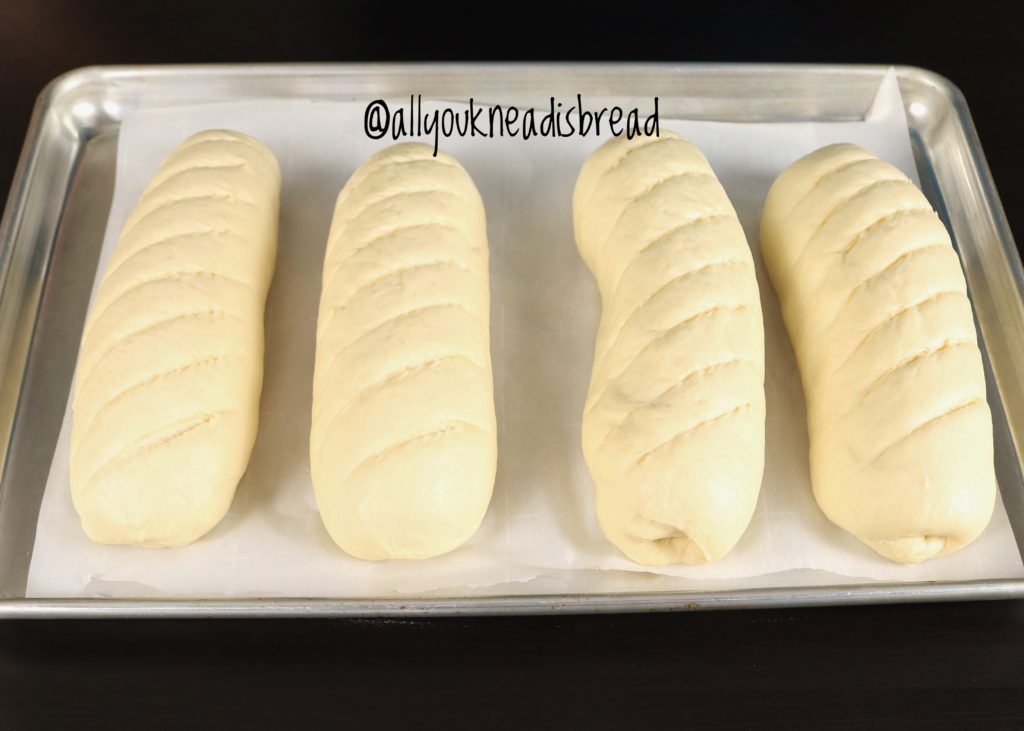
Bake the loaves for 25 minutes or until they are golden brown
NOTE: you might need to bake at lower temperature to make sure the loaves are fully cooked. You know your oven better!
When the loaves are ready, let them cool down on a cooling rack. I know it’s tempting but try to wait until the bread is at room temperature so the crumb finish baking and the aromas finish developing.
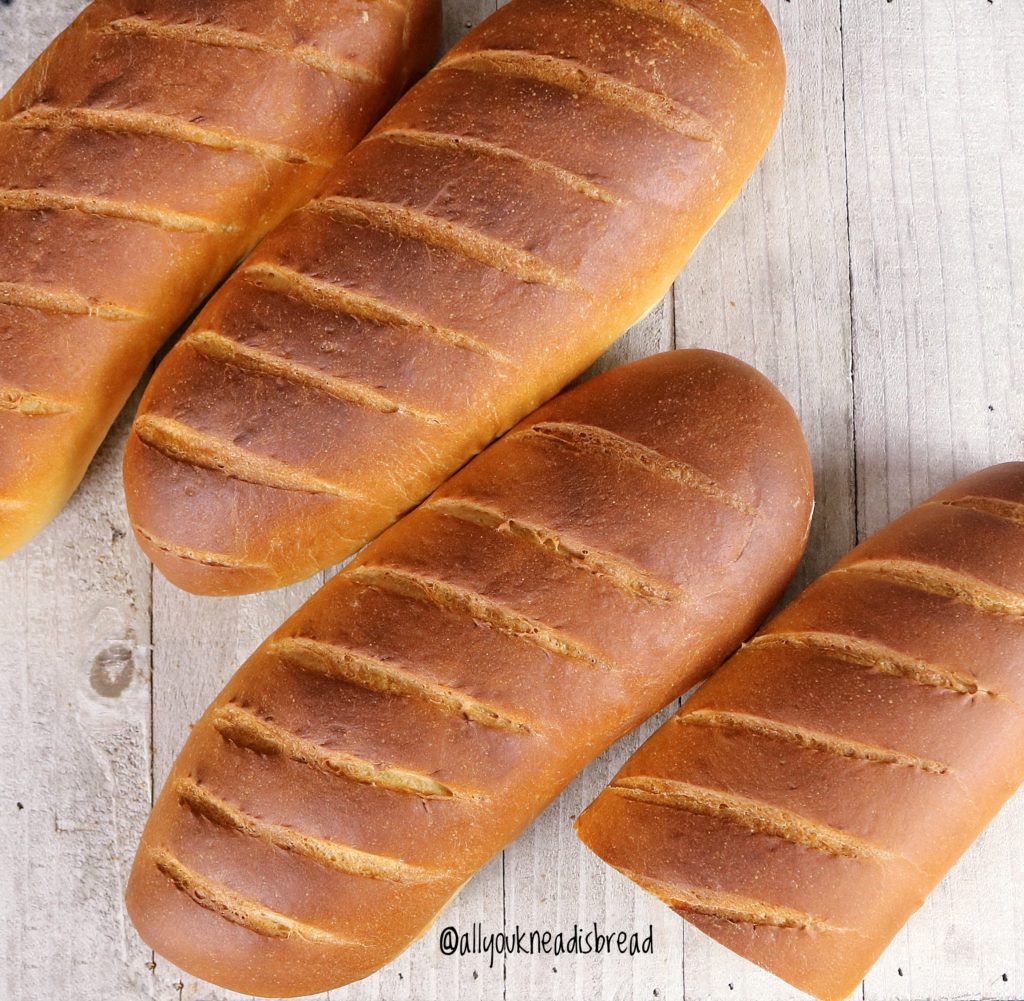
Enjoy!
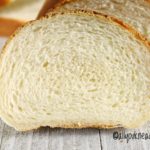
Russian Kefir Bread
A delicious and easy bread recipe
Ingredients
- 600 g bread flour sifted
- 175 g plain kefir
- 175 g water room temperature
- 6 g dry yeast
- 10 g salt
- 30 g white sugar
- 50 g unsalted butter softened
Instructions
-
Dissolve the yeast in the water and let it sit for 10 minutes
-
Add to the yeast mixture the salt, sugar, kefir, butter, and 200 g of flour and combine everything until you get a paste.
-
Add the paste to the leftover flour and incorporate all the ingredients until there are no dry flour particles. Let it sit, covered, for 20 minutes
-
Knead the dough until it's elastic and soft
-
Place the dough on a lightly oiled bowl and let it ferment, covered, until it doubles in size and it's puffy.
-
Deflate the dough and knead it for 1 or 2 minutes to make sure you get rid of big bubbles
-
Divide the dough in 4 equal pieces. Shape them into balls, cover them and let them rest for 10 minutes.
-
With a rolling pin roll the balls into a rectangle and shape the loaves.
-
Let the loaves rest, covered, until they double in size and they are puffy.
-
Make cuts on the loaves, brush them with water (optional) and bake them at 375 F for 25 minutes or until they're golden brown
Best Basic Challah
Finally! My first post!
I can’t believe it took me this long. Can you imagine that I spent most of the time deciding colors, styles, logos, etc?? It’s the first time for me to design something and let’s say that creativity is not my strength.
Anyways, here we are! Holiday time! A time where I’m sure Pinterest is on fire with people looking for recipes, décor ideas, centerpieces… When setting the table for any event, I like it to be more functional. I don’t like to have things between the people at the table that will make conversations or interactions difficult. I like to make the food be part of the ornaments.
Last week I went to a Friendsgiving dinner, and I was assigned the bread. We all came from different places around the world, many of the guests weren’t used to crusty bread ( as a Spaniard, that would’ve been my first option). So, I decided to make some soft bread. But dinner rolls seemed so not-holiday-worthy. There’s nothing wrong with dinner rolls, but I wanted something different, and tasty but not too sweet either. And I wanted edible decorations! Something to complement the table but that it’ll eventually disappear.
My solution? A nice challah!
I love challah because with simple ingredients you can make amazing things! I particularly enjoy the shaping. The 6 strand braid is my favorite, I think. It took me a bit to learn because I kept getting lost midway!
The loaf was a success! Everyone was taking pictures; some people had never heard of challah before and they were pretty impressed. And all that just because of the shape! Of course, when they actually tried the bread, they were even more impressed with the taste!
This recipe is from “The bread baker’s apprentice”, by Peter Reinhart, it’s my go-to challah recipe. I love this book, it has many different recipes, from different parts of the world. The book has great tips and in general, the ingredient lists are simple. I think it’s a great book for beginners and home bakers.
I just changed the type of flour, the original recipe uses all-purpose flour, but I like bread flour better. Enrich doughs have to be strong to be able to “lift” all the eggs, fats, and sugar. And also, I always bake with the same type of flour, and I can anticipate the amount of water I’d need or how the dough will behave.
But this is up to you really. Changing the flour won’t make the bread better or worse, just different! 😊
The original recipe also calls for vegetable oil. I chose olive oil because I love the combination it makes with eggs. I think both ingredients complement each other perfectly! You can use other shortenings, but I wouldn’t recommend butter. The reason is that it has a strong taste, and challah is all about the egg, I don’t want the butter to hinder the taste of eggs. But again, this is my opinion. You can make it the way you enjoy it most!
To make this challah you’re going to need the following ingredients:

- First, you need to activate the yeast. I like to use active dry yeast, but even when I use instant yeast, I activate it as well. Just to make sure it’s working well.
If your kitchen it’s cold, you can use lukewarm water to activate the yeast. If it’s hot, room temperature water works well. You can even add a teaspoon of sugar to the water. The yeast will feed on it, so it won’t add any extra sweetness.
Your yeast will be ready after a few minutes, and you should see some bubbles on top (maybe not as many as in my picture, I like to use a whisk to make sure the yeast dissolves completely, and that adds extra bubbles).
- While you’re waiting for the yeast, you can sift the flour, sugar, and salt into a bowl and stir it well to mix everything.
- Then add the yeast mixture to your dry ingredients
- And incorporate the eggs. You can whisk the eggs into the yeast mixture, or in a separate bowl and pour them into the flour, or like me, add them directly to your flour and yeast mixture.
Now it’s time for one of the most important steps, the autolysis step.
- Mix everything thoroughly, until you don’ see dry flour particles anymore and you have a sticky mess. If you think your dough is dry, you can add a little bit more water. Just 1 tablespoon at a time. Cover your bowl and leave it there for 20-30 minutes.
This step is important because it’ll allow the flour particles to fully hydrate before you start kneading. That means that the flour will work at full strength and the gluten network will be developed much easier.

After the autolysis step, the fun starts! Kneading time!
- Knead the dough in your most comfortable way. By hand or using a stand mixer with the hook attachment. At the beginning the dough will be sticky but don’t add more flour, keep kneading.
The dough is sticky because it has lots of eggs and sugar, So they get between the water molecules and the gluten proteins. So you must keep kneading to ensure all the gluten proteins get to link with each other and form the gluten network.
Regardless of your kneading method, eventually, you should see your dough coming together, getting more elastic, and getting some consistency.
- Now it’s time to add the oil (or any other fat or shortening).
If you’re not very used to adding the fat content midway, I’d suggest you add the oil little by little. One tablespoon at a time if you have to. Otherwise, you might get very frustrated.
Once the gluten network is halfway developed, it’s difficult to add fats, you have to keep kneading and squeezing the dough. It’ll eventually absorb the oil.
I like to squeeze the dough and turn it around and squeeze it again. I found that by doing this the dough absorbs the oil much faster. Also, trying to knead while everything is covered in oil… is not easy!
- After adding all the oil, keep kneading until the dough is not sticky anymore and the surface is covered by small blisters. At this point, the dough should pass the windowpane test. Remember to let the dough rest 5 minutes before you try to stretch it.
It took me around 20-25 minutes to get the dough ready. Your kneading time can be different, don’t worry. Your kitchen temperature, your skills, the stand mixer you use, or even the flour, play a role in the development of the dough. So don’t aim for time, but for dough consistency.
Look at the difference!

- Now you just need to put your dough in a bowl, cover it and let it ferment until it rises enough to be all puffy and about 1.5 times its original size. If your kitchen is cold, you can put the bowl in the oven with a pot with boiling water to create a warm microenvironment. Be careful not to turn the oven on!
- After the fermentation, deflate the dough and let it rest for a few minutes. Cut 6 pieces of equal weight and make small balls with each one.
You can use a little bit of flour for dusting, but try not to incorporate too much flour or your challah might end up dry.
You can shape your challah the way you like the most, a simple braid, 4 strands braid… you name it!
- Let the dough balls rest for 5 minutes. These resting times are important to let the gluten relax. 5 minutes can make a HUGE difference on your dough and it’ll be much easier to shape.
- After 5 minutes, take the first ball, flatten it with your hand, and with the help of a rolling pin, roll it into a 25 cm long oval (10 in approx) and 0.5 cm thick (1/4 in). Now, with the help of your hands, and starting on the widest part, roll it back to form a log. Repeat with each ball.

- Once the logs are ready, you just need to stretch them and make the strands. They should be about 50 cm (20 in) long. Start with the first log you made, since that one should’ve had more time to rest.
If at any point you feel that the strands keep getting back to their original shape, let them rest and come back a few minutes later. Try to make the strands in a way that is thicker in the middle and thinner on the ends. This way, the challah will have a beautiful shape, bigger in the middle and thinner on the ends.
- Time to braid the challah! I did not include a tutorial on the braiding part because I think it’s easier to understand if you see it in a video, rather than if you read it.
To avoid your challah from having a weird oven spring (meaning: end up with a terrible shape), try not to braid it too tight so you leave some room for the strands to rise.
- Put the challah on a baking tray and cover it with lightly oiled plastic wrap.
If you like a crusty challah, you can brush now once with the leftover egg whites, and a second time right before going into the oven. If you prefer it softer, just brush it once before going into the oven.

- Let the challah rise again until it’s puffy. It doesn’t have to double in size.
- Preheat your oven at 350 F (175 C)
- Once the challah has risen enough, put it in the oven and bake for about 20-25 minutes. After that time, turn the baking tray 180 degrees, so it gets to bake homogeneously.
If you think the challah is browning too fast, you can put aluminum foil on top and reduce the heat to 325 F (165 C).
Depending on your oven, you might need a bit more time, it’s okay. Just make sure that the inside it’s completely cooked.
And here it is!

I’m sorry I cannot show you how the crumb looked, but I can tell you it was awesome! Very soft, cohesive, and beautifully yellow!
I hope you enjoy the recipe. Below you can find a printable version with a detailed step-by-step.
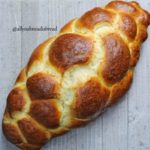
Best Basic Challah
Follow this recipe for a foolproof challah.
Ingredients
- 510 g bread flour (mine has 12.7% protein content)
- 30 g sugar
- 7 g salt *
- 4 g active dry yeast
- 30 g olive oil
- 2 large eggs
- 2 large egg yolks
- 215 ml water **
- 2 egg whites
Instructions
-
Add the yeast to the water and mix well. I like to use a wire whisk to make sure there are no lumps. Let it sit 5 mins to activate.
-
While the yeast is activating. Sift the flour into a bowl and add the salt and the sugar. Mix well with a wire whisk.
-
Once the yeast is active (you should see some bubble on top) add it to the flour mixture
-
Add the eggs and the yolks
-
Mix everything very well until you don’t see dry flour particles. If the dough is not cohesive, you might need to add a little bit more water. Do it half tbsp at a time. You don’t want to add too much water.
-
Let the dough rest for 20 minutes for a short autolysis. You can skip this step if you don’t have time, but I strongly recommend it since it’ll make your life easier when you have to knead the dough.
-
Start kneading the dough until it gets some consistency and elasticity.
-
Add the oil little by little until the dough absorbs it all.
-
Keep kneading until the dough is no longer sticky and you see small blisters covering the surface. It should pass the windowpane test.
-
Once the dough is ready, shape it into a ball. Lightly oil a bowl and place the dough inside. Cover the bowl and let the dough ferment for 1h approx. It doesn’t have to duplicate the size.
-
After 1h, deflate the dough, shape it again into a ball and let it ferment again until it’s about 1.5 times in size or until it’s puffy but not over fermented.
-
Remove the dough from the bowl, deflate it and let it rest 5 mins.
-
Divide the dough into 6 equal parts (if you’re doing a 6-strand challah)
-
Shape each part into a ball, cover them with plastic wrap and let them rest 5 mins.
-
Roll each ball into a 50 cm (20 in) log. Start making short logs and let them rest before rolling them to the final length. It’ll give the gluten time to rest and it’ll be easier for you.
-
Shape your Challah the way you’d like, line a baking sheet with parchment paper and place the Challah there.
-
Brush the Challah with the egg whites wash, cover it with lightly oiled plastic wrap and let it rise until it's puffy.
-
Preheat your oven at 350 F (175 C).
-
Once the Challah is ready, carefully remove the plastic wrap and brush again with the egg whites.
-
Bake in the middle rack for about 20-25 minutes and turn the baking sheet 180 degrees. Bake for another 20mins or until it’s golden brown (we turn the baking sheet halfway to ensure an even baking)
Recipe Notes
* You can omit the salt when you mix the dry ingredients and add it after the autolysis.
** You might need to adjust the water. The range should be anywhere between 200-250 ml.
Happy baking!









